Vassar honors MLK Day
Balsley Assistant News Editor
On Monday, Jan. 20, around 115 people attended Vassar’s annual Martin Luther King Jr. celebration. Due to a winter storm, the event was moved from the Villard Room to Zoom; however, the venue change did not seem to lower attendance compared to recent years. The event involved College administrators, alumnae, faculty and students, as well as a student from Kingston High School in Kingston, New York.
Deputy to the President and Secretary of the Board of Trustees Wesley Dixon, who led the event alongside Associate Dean of the College for Student Growth and Engagement Wendy Maragh Taylor, wrote to The Miscellany News, “I think it is always important to take moments to reflect on our history and how it relates to our current moment and our future trajectory. Celebrating Dr. King’s legacy is a great platform from which to do that.”
President of the College Elizabeth Bradley told The Miscellany News by email, “MLK inspires us to remember his commitments to justice, civil rights, and the collective good, and it is uplifting and impactful to reflect on his legacy in a shared space.” She added, “We hoped employees and students who joined would feel a sense of community—within Vassar and with the larger community.”
Sara Iglesias ’27 sang “Lift Every Voice and

and MENASA host drive
Vassar’s
Muslim Students Association (MSA) and Middle Eastern and North African Students Association (MENASA) opened their collaborative support drive for those affected by conflicts and humanitarian crises in Palestine, Sudan, Yemen and Congo on Jan. 26. The drive will be accepting clothing, food and supplies donations until Feb. 26.
The drive is seeking contributions of gently used clothing, particularly winter clothes, as well as non-perishable food and supplies such as first aid kits from students, faculty and community members. Bins have been constructed near The Retreat in Main Building, where those interested in donating can drop off items.
In an interview with The Miscellany News, MSA Senior Advisor Anisa Salahou ’25 explained that the idea for the drive came when MSA members began to brianstorm the ways that they could help the people affected by conflict in Muslim-majority nations during the winter break. After reaching out to MENASA, the two organizations decided to host a collaborative drive to provide support to those in need abroad.
“One of MENASA’s goals has always been to create an affinity space for Middle Eastern and North African students on cam-
pus,” said MENASA member Rosie Elebyjian ’27. “While we find a lot of comfort in one another, we also try to consider how we can utilize our safe space for community care and organization. It’s important that we do whatever we can to take care of ourselves, our loved ones, our families and our communities.”
After contemplating which countries would most benefit from the drive’s resources, the organizations elected to split the donated items between four Middle Eastern and North African nations.
“We picked Palestine because of the ongoing genocide that’s happening and also the genocide that’s happening in Congo,” said Salahou. “Sudan and Yemen are Muslim countries that are undergoing severe crises. When Muslims think about our ‘Ummah,’ which means the Muslim world, those are the countries that are most affected right now and that are suffering. A lot of attention is given to Palestine, rightfully so, but there are also other countries that are hurting as well.”
In the past, MSA has held other fundraising events in support of countries in need. After the 2022 floods in Turkey and Pakistan, the organization held a bake sale that raised over $1,000 for flood relief. When considering the best way to help the four nations in need, the organizations opted to hold a drive rather than host a fundrais-

Vassar College’s student newspaper of record since 1866
Spotlighting Dovetail
Erin Thatcher Guest Columist
Before my interview with the musicians, I knew that the word “dovetail” was used to describe two counterparts fitting together. I felt that it was proper practice to ask the indie folk duo, sophomores Brynne Mershon ’27 and Naomi Sullins ’27, about how they chose the name of their group—but when I cracked open the door of a dim-lit room in Davison House to find them sitting shoulder to shoulder on the bed with twin smiles and soft-spoken greetings, the answer to my question seemed obvious.
From their closeness, one would never guess just how different their paths over the last decade have been. Sullins grew up in Tampa, Florida. Her father was a worship leader and electric guitar player; to this day, he plays in bands with his brother. In her words, her father’s music was “the soundtrack of her life.” He was the one who taught her to play guitar. Her family encouraged Sullins to take piano lessons and sing in choir. From there, she started playing keyboard in a School of Rock program. Through this, she discovered a love for rock music and made new connections, which flowered into involvement with other bands in her home state over the years. Mershon came to Vassar from Milton, MasSee Dovetail on page 7
Jesse Koblin Contributing Editor
Kendrick
Lamar’s sixth studio album “GNX,” which was unceremoniously surprise-dropped on Nov. 22, is the antithesis of the mythology built around him and the logical conclusion of his recent output.
Lamar’s four-album run between 2013 and 2022 affirmed his status as hip-hop’s valedictorian, an avatar of street poetry, wordsmithing, politically conscious rap and epic concept albums. His work has always been experimental while firmly within the jazz roots of the Black musical idiom, aspirational yet crafted with sincerity and intentionality. Meanwhile, “GNX” is intentionally straightforward; a crowd-pleaser packed wall-to-wall with trap bangers, g-funk dance songs and R&B duets elevated by guest singer SZA’s lush vocal tapestries. While great music in and of itself, on “GNX,” Lamar avoids intricate wordplay, grandiloquent political messaging and heady conceptuality; as Lamar raps on the album opener, “wacced out murals,” “fuck a double entendre, I want y’all to feel this shit.”
The lack of an album rollout and limited promotional materials are also a surprise. Only two music videos were released alongside “GNX,” and the austere cover art merely displays Lamar in grayscale seated on the hood of the car which gives the album its name, framed by negative space. Compare this to
Have you ever experienced a terrible group project? See Nick Tillinghast’s article for something relatable.

his previous release, “Mr. Morale and the Big Steppers”—an album with cover art composed in the style of a Renaissance painting, music videos akin to one-act theater plays and a world tour featuring puppetry and shadow play set to plumes of pyrotechnics. The lack of highfalutin and high-reaching ambition is not characteristic of Lamar’s music. Was he phoning it in with “GNX?”
It would be tempting to say yes, if the music was not great. The track “luther” is a brilliantly low-key song set to an eponymous Luther Vandross sample, where Lamar’s steady drawl raps percussively under soaring SZA melodies. On this track, 808s interplay with lush strings and tinkly piano accompaniments, synthesizing old and new aesthetic traditions in R&B. Conversely, “squabble up” is a West Coast-inspired hit led by vibrant synths and bouncy call-and-response choruses; it is a funky and participatory earworm. “tv off” and “peekaboo” are trap-focused highlights that showcase features from little-known LA-native artists and a vivacious Lamar on the mic (referencing Supa Hot Fire on “peekaboo” and delivering a five-second-long producer tag where he screams “Mustard” on “tv off”). “man at the garden,” one of the more underrated cuts from the album, sees Lamar in an incendiary diatribe listing the dues he is owed over a stripped-back electronic rhythm. It is the peak of his introspection and emo-
See Lamar on page 5
Ben Vinson analyzes and critiques the letdowns of Mike Tomlin’s NFL career.


THE MISCELLANY NEWS
EDITOR-IN-CHIEF
MANAGING EDITOR
SENIOR EDITORS
CONTRIBUTING EDITORS
NEWS EDITORS
ASSISTANT NEWS EDITOR
ARTS EDITOR
ASSISTANT ARTS EDITOR
FEATURES EDITORS
OPINIONS EDITOR
HUMOR EDITORS
ASSISTANT HUMOR EDITOR
SPORTS EDITOR
ASSISTANT SPORTS EDITOR DESIGN EDITORS
ASSISTANT DESIGN EDITORS
COPY EDITOR
ASSISTANT COPY EDITORS
GRAPHICS EDITOR
GAMES EDITORS
SOCIAL MEDIA MANAGERS
LIVE EVENTS CHAIR
WEBMASTER REPORTERS/COLUMNISTS
CARTOONIST COPY STAFF
Allen Hale
Clara Alger
Maryam Bacchus
Carina Cole
Lev Winickoff
Jacques Abou-Rizk
Jesse Koblin
Charlotte Robertson
Nicolas Villamil
Emma Brown
Sarah McNeil
Julian Balsley
Emma Adams
Madeleine Nicks
Yaksha Gummadapu
Luke Jenkins
Soren Fischer
Oliver Stewart
Nicholas Tillinghast
Josie Wenner
Henry France
Casey McMenamin
Ellie Kogan
Lucas Seguinot
Amelia Gracie
Holland Kaplan
Darja Coutts
Kathryn Carvel
Grace Finke
Tori Kim
Sadie Keesbury
Felix Mundy-Mancino
Miranda Liu
Zoey Ojalvo
Fallon Dern
Kai Chang
Jordan Alch
Ben Kaplan
Anna Kozloski
Madeleine Nicks
Ian Watanabe
Andrew Chu
Sadie Baken-Durchslag
Paige Hahn
Quinn Kou
Angela Moon
Tess Novack
Edward Welch Morgan
CORRECTION POLICY
The Miscellany News will only accept corrections for any misquotes, misrepresentations or factual errors for an article within the semester it is printed.
The Miscellany News is not responsible for the views presented within its Opinions pages. Staff editorials are the only articles that reflect the opinion of a two-thirds majority of the Editorial Board.
Vassar community reflects on MLK’s message and legacy
Continued from MLK on page 1
Sing,” often called the Black National Anthem, at the event. Maragh Taylor asked Iglesias to perform a song of her choosing after seeing her in a performance of “For Colored Girls Who Have Considered Suicide / When the Rainbow Is Enuf,” a play produced on campus last semester by Robyn Lindsey ’25. Iglesias commented, “I was honored that they chose me.” She noted, “I mostly did it because I thought it would make my grandparents and my family really happy, and I was correct.”
The event’s speakers emphasized King’s messages of resilience, hope and nonviolence. Maragh Taylor connected King’s famous line, “The time is always right to do what is right,” with a quote by the late poet Nikki Giovanni: “There is always something to do. There are hungry people to feed, naked people to clothe, sick people to comfort and make well.” Maragh Taylor concluded, “So, may we look for the opportunities that are always here, not just today, to do what is right—for equity, for well-being, and all of that necessarily brings a level of care in our communities.”
Bradley referenced a passage from King’s last speech, delivered on April 3, 1968, the
day before he was assassinated. King said, “The nation is sick. Trouble is in the land. Confusion all around. That’s a strange statement. But I know, somehow, that only when it is dark enough, can you see the stars.” In response to King’s words, Bradley said, “I hope today his memory will be points of joy for each of us, that we will each bring compassion and love to our work together, and that we’ll see in the day glimpses of a better, more just world.”
Bradley expanded on her remarks to The Miscellany News: “MLK’s commitment to racial equity, connection, and love were important to hear at this polarized time.” Dixon expressed similar sentiments: “Dr. King’s commitment to service and social justice is fundamental to fostering dynamic communities. Especially in this moment where our nation is experiencing stark division, reflecting on ways to support a cohesive and loving community is ever more important.”
Associate Dean for Religious and Spiritual Life and Contemplative Practices Reverend Samuel Speers closed the event by reciting a few prayers written by King. The final one epitomized King’s commitment to nonviolent protest: “God grant that we wage the struggle with dignity and discipline. May
all who suffer oppression in this world reject the self-defeating method of retaliatory violence and choose the method that seeks to redeem.” Speers wrote to The Miscellany News, “Remembering King’s legacy is an opportunity for us to reflect anew on how we are part of something larger than ourselves in the movements for social justice in our time.”
Iglesias expressed some frustration at the event’s tone and its portrayal of King. “At the end of the ceremony, the Reverend closed it out, Sam Speers… He was giving a lot of quotes on how, like, the best way to respond to hate is with love,” noted Iglesias. “As if those were the only two options, to love and to hate. As if oppressed people should be expected to uplift themselves from their oppression by taking the high road.” They added of King, “He definitely was for peace and advocated for peace, but also, he has a quote like, ‘Riots are the language of the unheard,’ and definitely was more, I don’t know, open about discussing other means of liberation that are not peaceful toward the end of his life.”
In the 1967 speech Iglesias quoted, King once again professed his doctrine of nonviolence: “Let me say as I’ve always said, and I will always continue to say, that riots are
socially destructive and self-defeating. I’m still convinced that nonviolence is the most potent weapon available to oppressed people in their struggle for freedom and justice.” He then made clear that violence cannot be condemned in a vacuum: “At the same time, it is as necessary for me to be as vigorous in condemning the conditions which cause persons to feel that they must engage in riotous activities as it is for me to condemn riots… riots do not develop out of thin air.”
In another speech against the Vietnam War, King emphasized the necessity of speaking out against injustice, saying, “A time comes when silence is betrayal” and calling for the silence to be broken. Bradley commented on how this call relates to her role in the Vassar community. “I think often about Dr. King’s question about speaking out against violence in terms of ‘voice,’ particularly in terms of the voices of our community,” she wrote to The Miscellany News. “My biggest responsibility as President is to make sure Vassar fulfills its fundamental educational mission by enabling all members of our community to express their ideas and passions and find their voices. This is particularly the case when it comes to calling out violence against civilians and innocents.”
MSA and MENASA host humanitarian drive
Continued from Drive on page 1
er because they believed it would be easier for students to donate. “A drive is more accessible,” said MSA Secretary Lauren Jones ’27. “It’s easier for people to donate stuff that they already have, that’s just laying around that they’re not using.”
The organizations also elected to host the drive at the start of a new year, when many people are looking to help others or reorganize their possessions. MSA members explained that people may be more willing to donate items rather than giving a monetary donation because there is less apprehension
about how the money will be allocated and whether people in need will directly benefit from the donations.
“I feel like a lot of people are cleaning up their closets and have resolutions to under-consume,” said Salahou. “So I feel like that helps. It even helps me—I have a whole bag of clothes to donate and a lot of my friends have already told me that they have a bunch of clothes that they’ve gone through. So I think even though it is helping the affected countries, it’s also helping us be more intentional with the items we consume and buy.”
The donations collected through Vassar’s drive will be distributed by Helping Hand for Relief and Development, an international organization that provides both emergency relief and long-term support to countries in need.
“We would love to help even more countries, but it is really hard to find an organization that is connected to all of them,” says Salahou. “It’s hard to find an agency that’s able to donate physical items. So we did a lot of research over the break, but it was a little bit difficult to find places.”
Recently, MSA has also hosted vigil ser-
vices for martyrs in Palestine, in addition to other community events such as a Qawwali Night and an advice panel. MSA and MENASA are already looking forward to their next charitable event, working to provide support to those in need across the globe. “I feel like we’re always hoping to plan events in the future,” said Jones. “It’s part of our religion to be charitable.” MENASA treasurer Cezar Mahmoud ‘27 added, “Even though we are all expatriated, our countries of origin remain very dear to us. We love our peoples and we want to help out any way we can.”
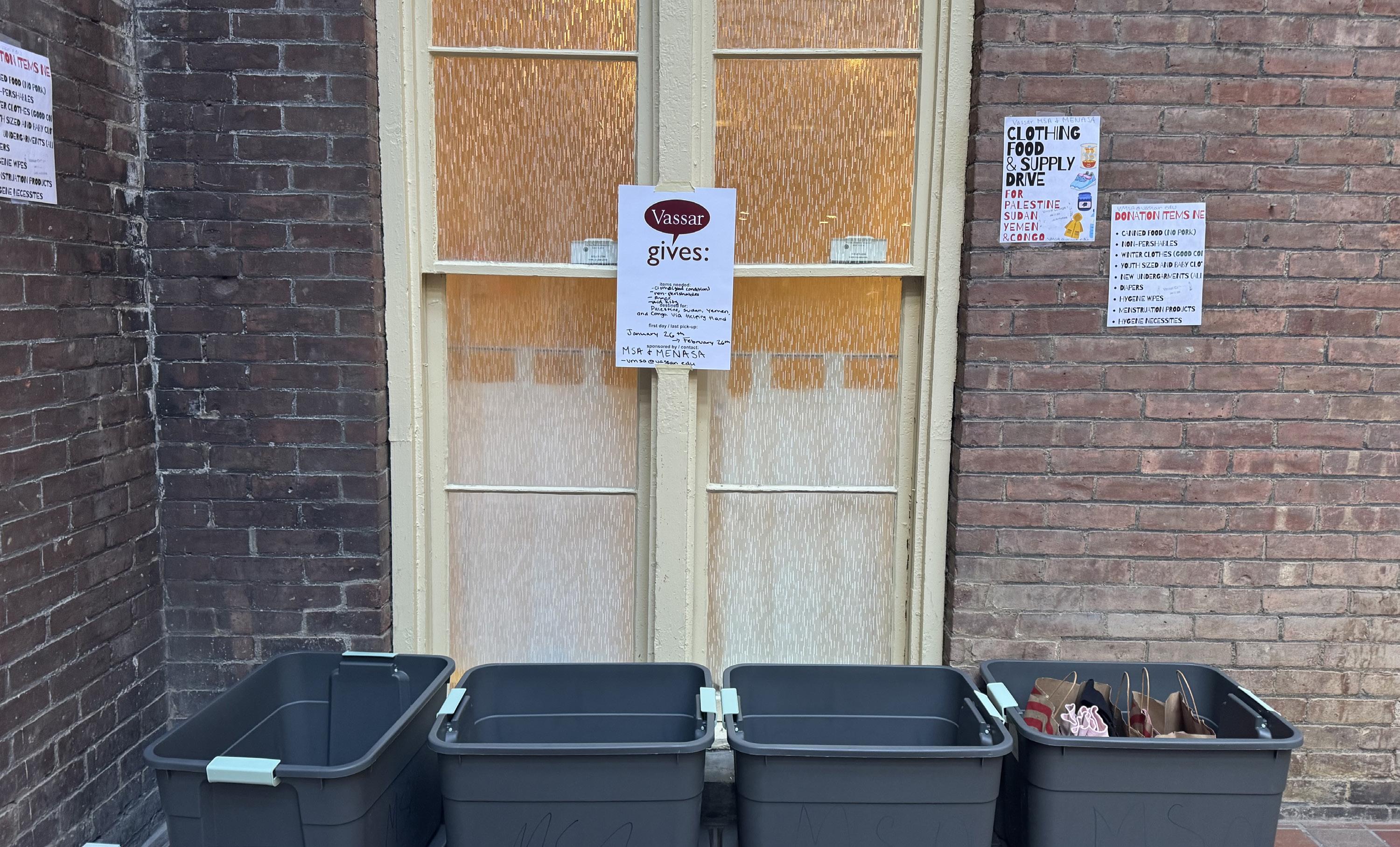
Questions remain unanswered in ‘A Complete Unknown’
Ben Kaplan Columnist
In a deep irony befitting anything connected to the famous singer-songwriter Bob Dylan, the new biopic “A Complete Unknown” is quite hypocritical. The movie is set during a time in Dylan’s life when he hoped to break free of the artistic conventions and norms set around him by those who had uplifted his career. Despite that fact, the film seems almost a carbon copy of what an average moviegoer would identify as the “modern biopic.” It does little harm but also does not reach the levels it should.
An adaptation of the novel “Dylan Goes Electric” by Elijah Wald, “A Complete Unknown” begins with Bob Dylan’s arrival in New York City as a cranky and jaded young man. It then follows Dylan up until his infamous performance in the 1965 “Newport Folk Festival” and ends with him even more cranky and jaded. The main appeal of this film lies in Dylan’s story and, even more so, in the depiction of him by the current Hollywood superstar of the moment, Timothée Chalamet. It is scary how versatile the young actor has already become, and he fits Dylan very well in appearance,
‘Nosferatu’:
Cailey Metter Guest Columnist
[SPOILERS AHEAD]
voice and mannerisms. Chalamet was, obviously, the main pull towards younger audiences, which explains the large marketing push towards exclusively showing scenes of just him as Dylan.
The other actors in the film with the most screen time were also pretty good, ranging from serviceable side performances to hyper-accurate and enriching versions of real people. Probably the weakest, though most likely because the script she was given made her performance insufferably boring and irritating from the get-go, is Elle Fanning as Dylan’s girlfriend Sylvie Russo, whom he fumbles like a poorly placed snap in football throughout the latter half of the film. The real standouts are Monica Barbaro as folk legend Joan Baez and Edward Norton as the kind-hearted Pete Seeger. The latter becomes Dylan’s mentor until Dylan gets irritable and decides hating everyone is more interesting for the plot.
The tragedy is that these great performances are stuck in a story that is not too enticing or rich. The attempts to add fun moments, mostly around Boyd Holbrook’s admittedly very entertaining depiction of Johnny Cash, dripping with charisma and soft mannerisms, add a bit of humor but
not much else. The events of the film play out like a mélange running down toast. There are almost no scenes that really leave an impression due to the inability to grab the audience with anything beyond the performances. Additionally, many of these performances are undermined by how hard it is to care about these characters when it is made abundantly clear the direction their plots are going, sometimes before they even say a word.
The ultimate shortcoming of “A Complete Unknown” is that it becomes an archetypical, mundane modern biopic that will land on TikTok in short clips in a few months. If you like that, and are a fan of Dylan, his music and the story that goes along with that, more power to you. But it is still a shame. Even something like Baz Luhrmann’s outrageously messy Elvis biopic had flashy imagery, guttural storytelling and some connection to our modern world in its messaging and plot.
“A Complete Unknown” is a story about rebellion and artistic risk told in a way that is criminally overdone. The modern biopic is acceptable but lacks depth. At its worst moments, “A Complete Unknown” just seems like a bunch of modern Hollywood talent
thrown into a big, tongue-in-cheek game of make-believe not too far removed from mediocre soap operas.
To focus on the positive, it is still a fine, acceptable film. I can see myself watching it in a few months on a plane or at a movie night where you do not want to debate what to watch, and I am sure Chalamet’s surprisingly impressive renditions of classics like “Blowin’ in the Wind” and especially “Like a Rolling Stone” will continue to hold up just as well on rewatch. With Chalamet breathing new life into a legend such as Dylan, especially given his recent performances of more obscure cuts on SNL from the singer’s catalogue, is more than admirable. I did expect more out of this film, but this upper level of mediocrity, where there is still solid pacing and great performances with a plot that does drag but has its fun, is more than easy to swallow. Would I have preferred a more in-depth and punctual piece on the forces that surrounded Dylan’s outlook on other people and art that could find modern comparisons and outline a real message, especially with this great cast? Of course. But, like a different Rolling Stone said, “You Can’t Always Get What You Want.”
Hauntings of a husband, wanton ways of a wife
Afriend wanted to see Robert Eggers’s recently released “Nosferatu” over break, and because I hate to read up on a movie before I watch it, I waltzed into the theater expecting a standard vampire movie and not a rat-infested horror nightmare. Prior to viewing, I thought: How bad could a vampire movie be? To say that I never watch scary movies is quite the understatement; “Scooby Doo” is the closest I venture into that genre. Of course I have gotten my feet wet with “Jaws” and the cult classic “Sharknado,” but those have a comedic touch that immediately takes away all of my fear. “Nosferatu” awakened the inner scaredy-cat that I often try to cover up.
In a world that likes to feed on fear of any kind, most people like to imagine themselves as fearless beings. Those that like scary movies must either crave the adrenaline rush or the feeling of bravery that these movies inspire. I am not one of these people. There is enough fear in my life—mostly imagined, but there nonetheless.
Immediately, I was drawn to the gothic-inspired muted colors and costumes of the movie. It takes you step-by-step through gray castles with a heart-stopping suspense. Expert camera angles guide the audience through the drama of meeting Count Orlok, acutely acted by Bill Skarsgård, rooms with rats and the nightmares of the characters: real and imagined. Thomas Hutter, Ellen’s husband, is sent to meet Count Orlok in order to sell him a cozy home. In reality, Count Orlok wants this home only to be near Ellen, his helpless victim.
While viewing this movie as a whole, what was scary was not necessarily the dreadful plague or the monster itself, but rather the lack of autonomy Lily-Rose Depp’s character had. At the end of the movie, to save essentially the whole world and her husband, she is forced to have sex with the monster Nosferatu. The movie did not even offer hope of a plan B; this was the
only way out. In the theater, these scenes irked and upset me, but it was not until I departed the theater that I could figure out why. It was the blatant oppression of the character, Ellen, and how she was controlled by the men around her in the film. At first, I thought the movie’s main purpose was the sexual gratification of Ellen and the monster together. Upon further analysis, I realized the movie is commenting on something greater. Ellen being taken by Count Orlok was not a part of the original 1922 film directed by F. W. Murnau. Instead, both Ellen and the monster manage to keep their clothes on, and the Count only takes Ellen’s blood. So why change the ending? Unless, of course, Eggers hoped to convey a deeper message, interweaving fear with a lack of autonomy.
Most women, and humans, can agree that losing their sense of self-determina-
tion is terrifying, and this discussion is increasingly relevant as women’s reproductive rights have taken a detrimental hit, pushing society further back in time. From this point of view, I can sympathize with Ellen’s character and appreciate her sacrifice. Thus, for some in the audience, the real fear—the real torment—of “Nosferatu” would be this lack of control, the blatant oppression of Ellen and the act she is forced into.
Though, for other viewers, there was a suggested note that Ellen’s sacrifice did not invoke sympathy or fear, but rather jealousy. In one of Ellen’s seizure-induced states, she remarks to her husband (Thomas Hutter, played by Nicholas Hoult) that he could not please her as well as the blood-sucking monster. Thus, this relatively bland husband character is determined to kill the undead monster in order to save his wife from
an unspeakable fate, or, I surmise, rather an unspeakable hit to his ego. At the end of the movie, when the audience experiences Ellen’s sacrifice and horror, the audience consequently see this act through a man’s eye—Thomas’—where he loses his wife to another man, possibly even one who is more of a man than himself.
Horror is still very much a foreign and obscure land for me: it does not bring me much enjoyment, and I am perplexed about why others actively seek it out. Despite this, I will always appreciate the shared feeling of terror and fear that a horror movie can invoke in a theater. It signals that humans do not have to be afraid, alone.
“Nosferatu” is able to artistically depict fear through a gender binary: the act of being lost and the act of losing. Audiences are demanded to look into the dark to see what scares them the most.
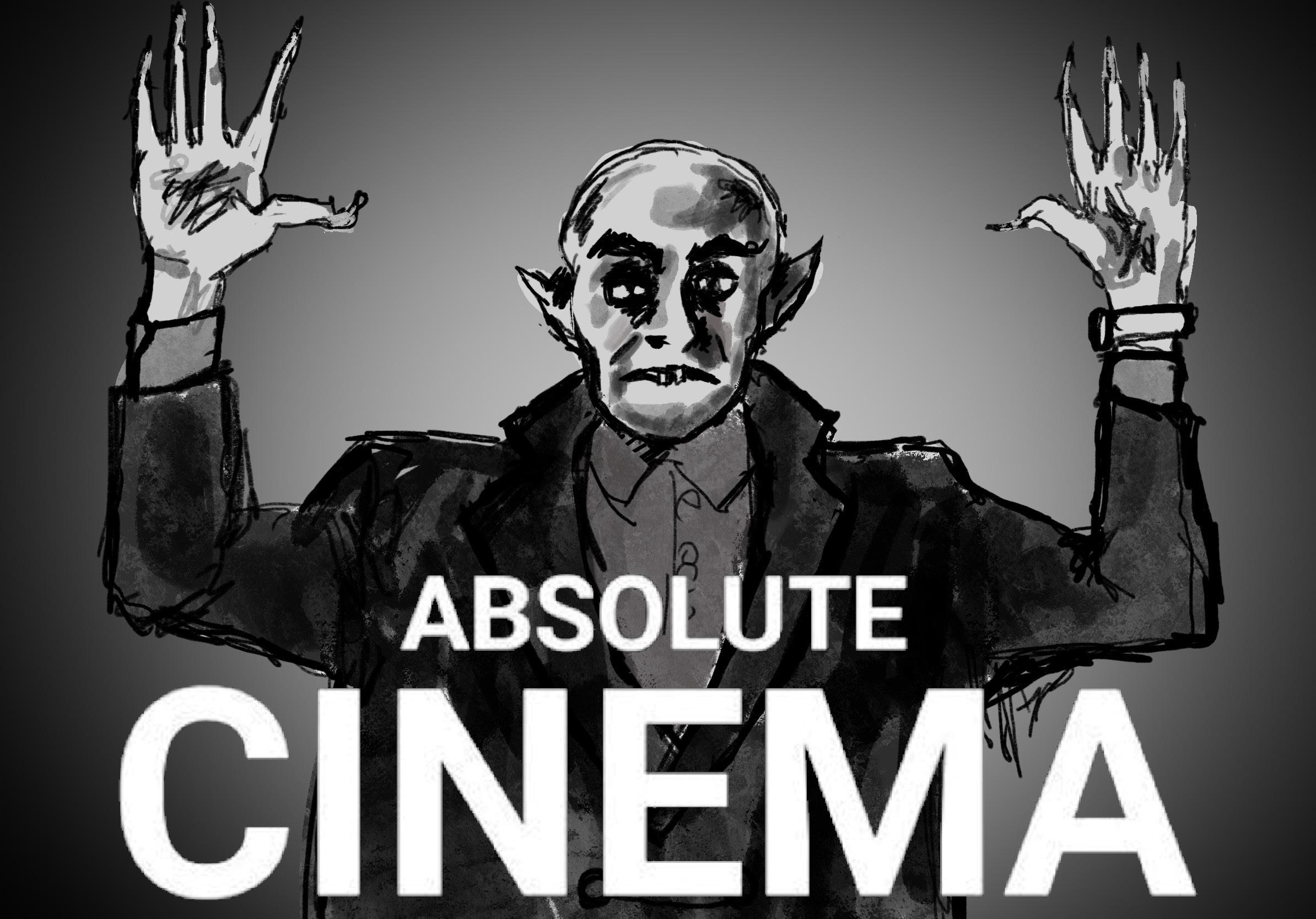
‘Severance’ should be your next watch
Would you mentally separate your work life from your home life? Imagine a scenario in which you could sever your “innie”—or work version of yourself—from your “outie” and never consciously go to work again? But, there is a catch. The version of yourself that goes to work would also have a separate life, separate friends and separate experiences. In theory, you would have two versions of yourself in the same body, and neither would remember the other. Would you do it, even if you were condemning a version of yourself to essentially work for life?
This is the concept that the show “Severance” explores. Directed by Ben Stiller and produced by Apple TV+, “Severance” is a purely unique viewing experience. Set in the near future or an alternate today (you can decide once you watch it), in a fictional town somewhere in America (or a version of America), we focus on the character Mark, played by Adam Scott, whom we follow through both aspects of his life—the “innie” and “outie” parts. Through him, we meet his colleagues and family, all of whom add different explorations to this idea of the “severed” work-life. The show not only explores themes surrounding capitalism, politics and criticisms of the modern workplace but somehow also involves humor, romance, mystery and suspense. In my opinion, “Severance” is one of the best shows to be created in the last ten years.
Entertainment is always something that we seek, whether it be from our phones, books, video games or television shows. We love to experience life through others’ eyes, to voyeur into a world other than our own. “Severance” envelops you completely, pulling you past simple entertainment to a
place of experience, making you sit in your bed at night pondering why there are goats in an office or what the employees truly do in the section of the company they call “macro data refinement.” The fictional office of Lumon plays a special role within the series. We come to learn it is a type of oligarch in this version of Earth,Which has taken over the world. The central mystery not only lies in who the main character is but: What is Lumon? Who are they? What is their goal? What makes “Severance” such an interesting TV show is that it develops layers of mysteries, and somehow without plot holes, it is a constant game of: Why this? Why right now? Who is in this scene and why? Why are they working at Lumon?
“Severance” is a show that you will want to speak to your friends about. When I watched the first episode I found myself asking everyone in my life the same question: “Have you watched ‘Severance?’ No!? Omg you should.” It is the best show to come out in the last ten years because it is not only entertaining, but also serves as a piece of art, which comments on contemporary life and the issues that come with the system we have set up for ourselves. The longer you watch “Severance” the more the characters’ lives seem to reflect and simulate our own, playing with the conventional notions of work-life balance.
Now that season two is here, it is the perfect time for you to start watching season one, as I promise you the second you start it you will not want to take your eyes off the screen. Ben Stiller masterfully controls this world; its characters and plot provide just the right amount of information, until you are so overcome by the story that you will be gasping out loud as everything starts to fall into place.
The cinematography and set design also add to the atmosphere as a whole. The dy-
namic panoramic shots and fluid camera movements mixed with the still shots of office life create an uncanny and disturbing feeling—you will always be on the edge of your seat. There is a distinct difference between the world outside and inside Lumon. Inside it is geometric, sharp, bright and white, void of any color apart from green, blue, yellow and white, making color in the scenes set in Lumon stand out and serve as a plot marker. The set design also allows the outside world to seem completely different, in a way that you cannot tell. This is done through simple manipulations of the background and composition of the shots. Darkening the outside world is one of the more notable of the subtle changes. Lumon uses harsh fluorescent lights, making it seem bright and almost barren. This makes darkness of natural light more emphasized and clearly allows the viewer to make distinctions between the inside and outside. Everything you see is purposeful: Color, outfits, dialogue and time. There is nothing within this world that does not matter. If you watch “Severance” once you will understand
50 percent, but if you watch it a second time, you will be watching a completely different show. Everything has its own plot, history and purpose. The purpose behind everything makes the show stand out above the rest. Nothing that you see is unimportant. The information that you are given is the information you need. I argue that “Severance” is the best show on television today because it engages you intellectually. The show, due to its multiple storylines and images, creates a map of clues and mysteries that allow for you to engage even when you are not watching it. The show makes you reflect, think and ponder on our version of the nine to five. How are we any different than the “innies”? Do we ever get freedom outside work? The “outies” do not even get that luxury, they live in Lumon houses, in a Lumon town and even wear Lumon clothing. Their life is work, and work is life within this world. But is it not also similar to ours? I invite you to watch “Severance” and really sit with it, look at the set design, the sequence of shots and look at what each episode is called. Look at it and experience what you are seeing.

Kendrick Lamar redefines priorities on ‘GNX’
tional intensity on the record, a view into his meditation on success amidst the (deserved) braggadocio on the rest of the album. Though “GNX” is in some ways an eclectic grab bag of sounds and styles, the through line is their poppy, commercial focus. These tracks are a far cry from the poignant cultural incision of “Mr. Morale,” where songs like “United in Grief,” “We Cry Together” and “Father Time” utilize dramaturgy to explore the emotional tumult of paternal relationships and marital disputes.
It may have been inevitable that Lamar would step away from the thematic messaging and intricate songcraft signature to his style. He has the most formidable discography in the current hip-hop landscape; for example, 2012’s “Good kid, m.A.A.d City” is a cinematic musical narrative charting through extensive narrative skits of Lamar’s experience growing up in Compton. 2015’s “To Pimp A Butterfly” is a transcendent, sweeping encapsulation of the Black experience in America, a wildly ambitious tour-deforce widely lauded as a masterwork. 2017’s “DAMN.” and 2022’s “Mr. Morale and The Big Steppers” are both more introspective and interpersonally focused than political but carry forward Lamar’s tradition of conceptual albums by dissecting his role as an artist and analyzing his demons. His 2011 debut studio album “Section.80,” while not as critically regarded or grandiose as his later work, is in its own right an ambitious musical effort reflecting on the experience of Black millennials operating in the systemically racist landscape wrought by Reaganism.
Given the pedigree of critical darlings that precede “GNX,” it makes sense that Lamar would step away from the conscious roots that built his reputation as a rap messiah. This narrative is especially salient after the reception of “Mr. Morale,” which was received positively but viewed as an anticlimax in light of the five-year wait for new music and the expectations reinforced by his prior works.
“Mr. Morale” had to match “To Pimp A Butterfly,” which was hailed as the best hip-hop album of the 21st century, and “DAMN.,” the first hip-hop album to win a Pulitzer Prize; falling short of that standard may have signaled a change in Lamar’s artistic trajectory.
“GNX” must also be understood as a victory lap following Lamar musically slaying Drake in their rap beef that transpired last summer. Their caustic feud was initiated by Lamar’s verse on the rapper Future’s track “Like That” and spiraled into a precipitous exchange of musical blows that quickly became transgressive and mean-spirited. Although Drake’s “Family Matters” is considered a highlight diss track to come from the beef, Lamar handedly won the beef through a series of response tracks best described as a scorchedearth rap polemic. Songs such as “euphoria” and “Meet the Grahams” delivered a scathing, psychoanalytic dismantling of Drake’s authenticity, systemically tearing apart not only his claim to belongingness in the rap industry but his integrity as a human being. The release of Lamar’s summer anthem “Not Like Us” this past May cemented Lamar’s decisive victory, as the song was not only a crushing final blow to a humiliated Drake but also a sensational hit that recently surpassed a total
billion streams on Spotify. Although Lamar has always been a highly respected artist in hip-hop and the only rapper of his generation with a similar consensus of critical acclaim, “Not Like Us” cemented him as a beloved character, symbolizing the coalescence of his artistic prowess as a hip-hop practitioner and his clout within hip-hop culture itself. In this context, “GNX” reads as a triumphant continuation of the anthemic career run that “Not Like Us” initiated.
“GNX” is not devoid of artistic flourishes; even in making a “straightforward” album, Lamar still cannot keep his promise to abstain from double entendre. The album closer “gloria” best represents this, a glittering flamenco-tinged and SZA assisted ballad where Lamar seemingly recounts the obdurate, tempestuous love between him and his fiancée Whitney Alford. Really, Lamar speaks about his relationship to the pen: “wrappin’ my hand ‘round your waist / That was back when you did whatever I say,” Lamar raps, recounting both his romantic affection and creative muse as bittersweet sources of pain and pleasure, success and struggle. While clever in its own right, the song’s subject being a metaphor is a well-trodden rap trope— Common’s “I Used to Love H.E.R.” and Kanye West’s “Homecoming” both represent stronger examples of the narrative trick in play.
It is impossible not to mention “reincarnated,” the most conceptual track on “GNX,” where Kendrick hops on a winding Tupac-inspired piano beat. On this song, he frames himself as the most recent incarnation of the Black musical canon, recontextualizing the careers of blues innovator John Lee Hooker
and jazz legend Billie Holiday as two of his prior lives. The third verse of this track is peak heady, lyrically transcendent Lamar; here, he speaks in intimate communion with God, negotiating his role as a Black musician and working through his ambiguous moral polarity between divinity and sin. Unfortunately, the first two verses are let down by a grating vocal performance where Lamar growls into the mic—he is an artist known for his penchant to adopt different voices, and while never an issue in previous records, his vocals here nearly veer on corny. The lyricism in the first verse is also noticeably second-caliber. Lines written from Hooker’s perspective, such as “And so I’m off in the sunset, searchin’ for my place in the world / With my guitar up on my hip as the story unfurled,” seem underwritten coming from an artist known for masterful storytelling on tracks such as “Sing About Me, I’m Dying of Thirst,” “DUCKWORTH.” and “Untitled 05.”
Despite some missteps, Lamar still makes great music. “GNX” is a testament to his consistency and auteurial power even when constructing an album that is purposefully lower-scale and commercially focused. Regardless of how it stacks up, “GNX” is a refreshing chance to see Lamar revel in the spoils of success and have fun with his music unfettered by lofty artistic aspiration. Beyond its role in the hagiography of his career, “GNX” is also a massively successful record, capturing the energy of rap culture in the aftermath of the Kendrick-Drake beef. Lamar’s claim on the early beef diss track “euphoria” is even more salient today than during its release in April—“I’m what the culture feeling.”
FEATURES
The emperor’s new clothes (are ugly): On Melania’s hat
Eduardo Culmer Guest Columnist
From the red smurf hats seen on radicalized, discontented peasants during the French Revolution, to the iconic tricolor suffragette sashes worn by women fighting for their rights in early 20th century America, fashion and politics have always gone hand in hand. “Fashion is instant language,” notes eponymous luxury clothing designer Miuccia Prada. “What you wear is how you present yourself to the world.” Throughout the course of human history, certain clothing items and aesthetics have been co-opted by groups of people to silently signal social, religious, or political ideals. In a society driven by appearances, the clothes we wear often make a statement about our identities and beliefs.
Whether it be through boldly wearing a camo-green Zara jacket stating “I REALLY DON’T CARE, DO U?” while visiting undocumented children at the Texas border or flouting Gen Z—and therefore unfashionably leftist—beauty standards by wearing skinny jeans on a disaster relief trip to North Carolina and California, First Lady Melania Trump has always used fashion to make a statement.
With one big statement, the recently re-appointed FLOTUS stole the stage from her husband at Washington’s largest media circus of the year: Donald Trump’s second Presidential Inauguration.
Mrs. Trump attended the event wearing a double-breasted coat made of dark navy silk wool over an ivory blouse and skirt—all made by New York-based designer Adam Lippes. However, the article of clothing that really stole the show was a wide-brimmed navy boater hat made by likewise New Yorkbased designer Eric Javits. Almost completely obscuring the First Lady’s eyes à la the Pizza Hut logo or Jim Carrey’s character in “The Mask,” Mrs. Trump’s hat has been widely memed and maligned across social media platforms and news outlets. Due to our innate tendency to broadly distrust people who shield their eyes from view, the First Lady comes off as less effortlessly elegant and more cartoonishly evil, like an animated Disney villain who hates children and trips off a cliff in her stilettos during
the film’s third act. Many viewers left the inauguration broadcast questioning several things: What will our country look like in the next four years, who invited all those tech titans to stand at the right hand of the incumbent president, and… why is Melania wearing that hat? While only the future holds many of the answers to our questions, one can be solved by looking to the past.
“Fascism is fundamentally and at bottom an aesthetic conception,” asserts English novelist Louis de Bernières: clean lines, monochrome color palettes, appropriated Roman imagery, well-tailored and austere clothing. Due to the dissemination of visual propaganda by fascist leaders in the mid-century and the portrayal of these images in the modern day, the fashion of fascism is instantly recognizable to people around the world. During his most recent campaign, many concerned historians have noted President Trump’s steady decline into fascist ideology, and as his policies skew further to the right, so too do the fashion choices of his associates and supporters.
Within recent years, we have seen a rise in conservative dressing by proponents of the “trad-wife aesthetic,” who propose a return to traditional gender roles along with longer hemlines and modest florals. This move towards a more conservative style of dressing has trickled down to affect the tastes of almost all age groups, with many Gen Zers and Millennials alike gravitating towards “old money,” “cottagecore” and “quiet luxury” aesthetics inspired by a return to a “simpler,” more idealized way of living and dressing. A similar turn toward both minimalism and pastoral beauty took place in Nazi Germany, where womens’ fashion in Berlin became a balancing act of stark, sleek coats and flowy milkmaid dresses. Aside from the stiff, tailored suits synonymous with the Nazi dress code (and, of course, with absolute power), “folkloric clothing became another kind of uniform, suggesting a simpler, Alpine life,” according to MPR News. This style of dress “served to [reinforce] Nazi gender politics (...) with its tight-waist, flowing skirt, apron, and decollete.”
Between the Adam Lippes coat/Wicked Witch hat combo and the dramatic black and white silk gown she wore to the inaugural ball, Melania Trump’s inauguration
looks balance conventional femininity with something sharp and imposing. And she was not the only one, with many other members of the president’s and vice president’s families following a similar dress code. Opting for Chrisitan Dior’s “New Look” silhouette, Ivanka Trump similarly walked the line between conservative womanhood and “authoritarian-chic” at the inauguration in a super-cinched yet tailored monochromatic skirt suit and hat. Pioneered in 1947 as a clapback to the increasingly practical and loose-fitting shape of women’s clothing, Dior’s “New Look” symbolified society’s shift towards conservatism and a general return for women to the domestic sphere. The silhouette’s small waist and full skirt became widely popular in the 1950s and has since come to symbolize the narrow identity women were expected to assume at the time. In 2025, with President Trump’s recent assaults on Diversity, Equity and Inclusion (DEI) programs and executive order declaring that there are only two genders, the fashion of the Right similarly seeks to reinforce gender stereotypes and repre-
sent the overbearing power of the newfound conservative government.
Inauguration fashion is usually used as a basis for fashion magazines such as Vogue and Vanity Fair to make predictions on what the clothing choices of the empowered administration will be for the following four years; this year, with the immense influence of the first family over millions of Americans and the already established history of politicized fashion in the Trump presidency (e.g. the infamous and inescapable red MAGA hat), much more can be gleaned from the sartorial choices of America’s first family. Melania’s hat is not just a funny meme to be spread across the internet, and Ivanka’s suit does more than share a startling resemblance to an outfit you would see in “The Handmaid’s Tale.” These fashion choices, no matter how small, wordlessly communicate the politics of the people who make them. They point us in the direction our country’s culture will shift in the coming years. And if Melania’s hat is any indicator, I can say with certainty that the future looks pretty goddamn ugly


FEATURES
Spotlighting the folk duo Dovetail
Continued from Dovetail on page 1
sachusetts. Her love for music started with instruments such as flute and piccolo, as well as singing in choir; but it took off running when she found a dusty old guitar in the basement that her mother had bought many years prior. She taught herself to play the guitar and learned bass to join a jazz ensemble. With these skills, she wrote songs and played in local bars.
In their teenage years, the duo used their talents as a remedy for melancholy and loneliness. Sullins wrote her first song during her first heartbreak, and to this day, it remains her favorite. “I still have the original voice memo,” she recalled during a spoken correspondence with The Miscellany News. “I know it sounds so cheesy, but music really is healing. It’s such a beautiful outlet for your emotions.” Mershon recollected driving along the forested winding roads of her hometown, a solitary activity that gave her comfort as she listened to her favorite music and developed ideas for her own. With a soft smile, she recounted playing a small gig at a local farmstand in the area when she was younger, “I remember my mom sitting at a picnic table nearby recording.” The through line in these heart-warming stories of sincere beginnings is a blossoming passion for the acts of performance and songwriting—and as it turns out, that passion was exactly what brought the unlikely pair together from a thousand miles away. Their story is a reminder of the many beautiful things in life that happen by chance. They met at an open-mic event in the Mug
run by Student Music Union (StuMu), a student-run organization that both the artists now work on the executive board for. Sullins said that she rarely goes up to people spontaneously, but after watching her bandmate’s set, she decided to swallow her pride. She knew from the beginning that they needed to make music together. They quickly bonded over Elliot’s Smith, “Twilight,” which Sullins had performed that night. That was only the beginning of an unexpected friendship built on bonds created through shared artistic collaboration.
The group settled into the indie folk genre, like Smith, as it’s a genre that they have both gravitated toward, both in listening and writing. Sullins has a history writing electronic music, but she has found folk more therapeutic: “There’s a reason people have been doing it for centuries. It helps to process the world, and it’s pretty to listen to.” Her counterpart agreed, having written folk music from the beginning. The fact that Dovetail is a duo helps them to succeed in this genre from a technical standpoint—two voices and two instruments ensure a full, balanced sound. With Sullins on the guitar, Mershon may oscillate between guitar, banjo, mandolin, or even the tambourine.
They told me about an original song they wrote together sitting on the floor in Jewett House, entitled “Three of Cups.” The pair had intended to write music for a student-run rock band, No Such Thing, but they veered off track and wrote an indie folk song instead. They gave me some insight on the process of
writing. “We both like to jot our ideas down,” Mershon said, “so we could pick and choose which lines to use.” Sullins recollected the surprising ease of the song’s creation, describing what sounded like a seamless flow. “We were filling in the gaps in each other’s ideas,” she said. “Someone would have the start of the verse, and then the other would find a rhyme.” A week later, the pair performed the song at the Frances Lehman Loeb Art Center. More recently, the artists were able to rent out a studio in the Catskills with friends for a day to record the song, a rare experience realized by hard work and talent. The song is now in the process of being mixed. “It was such a great experience,” Mershon reflected. “It was the first time I’ve paid for studio time.”
The artists remained transparent that what they do is not always smooth sailing. “I struggle with impostor syndrome for sure,” Mershon admitted, with Sullins subsequently voicing support for her friend. It was clear during this conversation that the duo may believe in each other more than they believe in themselves. Mershon continued to say that she used to have terrible stage-fright, and that this battle is still a work in progress. Along a similar vein, Sullins voiced that “the main antagonist with producing and performing music is anxiety,” recalling experiences quelling panic attacks onstage. It appears that these kinds of toils are ongoing battles that artists may always face to some degree—it is only a matter of supporting one another and learning the best way to combat these negative emotions. They have adopted the attitude
that whatever happens onstage is not definitive of their ability. It is hard, but as Sullins says, “you do it anyway because you love it, and it’s always worth it.”
When asked what stories they would like to tell with their music, the two discussed in agreement that some of the power of music lies in the fact that, at times, no story needs to be told at all. “One of the best things about music is that it can convey things about language,” Sullins said, “and that’s what we both like to tap into.” They talked about the possibility of exploring ambient music, focusing on sound rather than lyric, citing Ethel Cain’s new album as a potential source of inspiration. From there, they settled into a conversation about love and growth. Sullins first expressed a tiredness with writing on the subject of love. “In some way, every song I’ve written has been about that.” Mershon mused that it is also true that “love is the most important thing. There’s always such a focus on romance; there are so many other kinds of love to focus on, and so many ways to explore it. There are a lot of possibilities.” Sullins then cited interests in love that are nature-oriented, divine or planetary; but the kind of love that resonated most clearly in my time with Dovetail was the platonic kind. “This is what we’re working on right now,” she concluded, “exploring the possibilities of what we do.”
In the near future, you can find Dovetail at many events run by StuMu. Follow them on Instagram @dovetail.band to stay updated on their journey, and look forward to seeing them play in the Folk Fest this spring!
Reimagining a classic with Broadway’s Romeo + Juliet
“RomeoSydney Jones Guest Columnist
+ Juliet,” the latest and 37th rendition of Shakespeare’s classic tragedy to be brought to the Broadway stage, is an adaptation that is certainly no fool of fortune. The production, directed by Sam Gold, stars Rachel Zegler and Kit Connor in their Broadway debuts as the titular star-crossed lovers. The play reimagines its source-material using a youthful, genuine sense of humor while its staging and choreography (by Sonya Tayeh) create an immersive experience that could only exist at such a unique venue as The Circle in the Square Theatre.
Upon passing through the revolving glass doors of the theater, which sit underneath bright pink and yellow signs with the names of the stars and an awning of marquee lights, audience members descend via escalator into a neon, teddy bear embellished world where ambient music inspired by the show’s soundtrack bounces through a packed lobby. Created by acclaimed producer Jack Antonoff, the show’s sound design is upbeat and electronic; reminiscent of recent pop culture phenomena, like the score from “Challengers” (2024) and Charli XCX’s “Brat,” whose song “360” can be heard among the club-inspired playlist put on just before the doors open and the audience find their seats. Once inside, there is a small “preshow,” in which the cast can be seen playing cards, eating gummy bears, playing hackysack to the music and lounging on stage before the lights dim and the show begins. For the duration of the show itself, Antonoff’s soundtrack is played live by a keyboardist perched on the far side of the theater to match the beats and emotions of the actors’ dialogue, which is recounted in the original iambic pentameter. At one point, the keyboardist even delivered a few lines to decline a staged request from Gían Pérez (Samson/
Paris/Peter) to play the song “We Are Young” from Antonoff’s former band, “Fun.”
In both the show’s staging and the selfaware tone through which the actors reimagine the execution of its well-known lines, there is very little barrier separating the characters and the audience. Gabby Beans (Mercutio/The Friar) delivers the play’s quintessential opening narration, inviting the audience to be engaged onlookers not just to scenes of “fair Verona” but to the performances of the young cast as they bring age-old lines into the modern world of the theatre-in-the-round. The characters leap through the aisles and address audience members, with Romeo (Connor) delivering his iconic balcony monologue while leaning against the rails of the standing-only section and dangling from the levitating bed that acts as Juliet’s bedroom. Beans makes her first character transition after her time as the narrator by announcing “I’m The Friar now” in one of the more abrupt examples of how the actors switch between their two or three characters. In this way, not only is the talent and dynamic energy of the whole cast put on full display in their physical and
Once inside, there is a small “pre-show,” in which the cast can be seen playing cards, eating gummy bears, playing hacky-sack to the music and lounging on stage before the lights dim and the show begins.
emotional transitions between scenes, but there is also a certain humorous yet genuine self-awareness in the show acknowledging itself as an adaptation intended for a new generation. It is executed by a young cast and caters to a young, excited set of viewers— staying true to Shakespeare’s somewhat ironic, irreverent tone but amplified for a modern (specifically Gen Z) audience.
The Circle in the Square Theatre is also a fitting setting for the show’s dynamism and creates a true sense of immersion. For example, after Romeo and Juliet first meet at the Capulet party and realize themselves to be members of opposing households, the surface of one-half of the round stage splits and flips like the page of a book, hinging to create a 90 degree angle before resting parallel on the other side. As it slowly folds, their figures are left shadowed and searching to catch a glimpse of each other across opposite sides of the semi-circular wall, literally representing the story forces pushing the star-crossed lovers apart. Once the stage lies flat again, the new surface is revealed to be covered in a carpet of flowers. The now sunken-half of the stage later doubles as The Friar’s garden, the setting for the death of Mercutio (during which Beans delivers an amazing, emotional performance), and the springboard for Romeo’s “pull-up” to Juliet’s balcony.
As for Connor and Zegler’s performances, I would say they certainly live up to the hype of their movie and TV fame, coming from roles like Connor’s Nick Nelson in Heartstopper and Zegler’s Maria in West Side Story (2021) and Lucy Gray-Baird in The Ballad of Songbirds and Snakes (2023). From the time they spend perched on top of the two tunnel stage entrances in the first act, to their chemistry in the Capulet party scene and their final words to each other as they lay dying in the Capulet tomb, there is no denying that they are both supremely talented actors. Connor brought a new life to
his character—as cliché as it might sound—in his balcony monologue, where you could hear his character’s internal struggle and endearingly naive smittenness in the classic lines used to ask advice from the audience and build up his confidence to address his love. During his visit to the apothecary, you can see the dramatic tone drop in his eyes as the story advances down its tragic path.
His co-star, Zegler, has a voice made for Broadway. Although the show is not technically a musical, at the end of act one she performs the original song “Man of the House” on a darkened stage with only a handheld mic and a spotlight. It is as if her character is performing alone in her bedroom, or in front of a mirror, in a brand-new dramatic monologue that adds another dimension to her character not seen in Shakespeare’s original version or any other of the many adaptations. Having been familiar with her performing talent from previous roles, it was special to see her deliver such raw emotion in person using just her voice.
The supporting cast is just as incredible— including Tommy Dorfman as The Nurse/ Tybalt, Sola Fadiran as Capulet/Lady Capulet and Taheen Modak as Benvolio. Many of these actors split their time between characters who are moreso foils for each other than similar, and the contrast in their performances from scene to scene only emphasizes their talent.
Though “Romeo + Juliet” would certainly make a 16th century Elizabethan child die of culture shock with its over-the-top costumes, endless innuendo and Paris’ choice of vape, it would not be before they let out a good cry and a little giggle on the way to their grave. I want to bottle up the feeling of joy I experienced during this show and carry it around in the “borg” bottle of Lord Capulet and Romeo’s final toast, because this is my new favorite take on Shakespeare’s tragic tale of fate.
Interview with a Vassar College student-vampire
Wenner Vassar College Student-Student
Today, I’m sitting down with legendary vampire Count Orlok to talk about his recent transfer to Vassar College!
Josie Wenner: Hello, Count Orlok! Thank you for sitting down with me to have this chat!
Count Orlok: HUUUUUUUH I am delighted HUUUUUUH to be having HUUUUUUH this conversation.
JW: Well first of all, the question on everyone’s mind: What made you decide to transfer to Vassar? Your old school was a very different place.
CO: HUUUUUUUH I previously attended HUUUUUH Pennsylvania State University. HUUUUUH I meant to enroll HUUUUUH at Transylvania State University HUUUUH but I misread the name on the HUUUUUH application. Vassar HUUUUH seemed like a place more suited HUUUUH to my tastes.
JW: Was there anything at all you liked about Penn State?
CO: I very much enjoyed HUUUUH the fraternity rush. HUUUUH I have truly formed unbreakable bonds HUUUUUH with men I am proud to call my HUUUUUH brothers. They have HUUUUH taught me how to do HUUUUUH the keg stand.
JW: That’s super cool! Now, moving onto Vassar: What are your initial thoughts?
CO: HUUUUUUH I am enjoying Vassar College. HUUUUUH I am living in a Town House with many HUUUUUH fellow students.
JW: You seem to be acclimating well so far. What classes are you taking?
CO: HUUUUUH Advanced Biting, Prowling with Intent, The Art of the Slaughter, and HUUUUUH Introduction to Women’s Studies.
JW: Women’s studies?
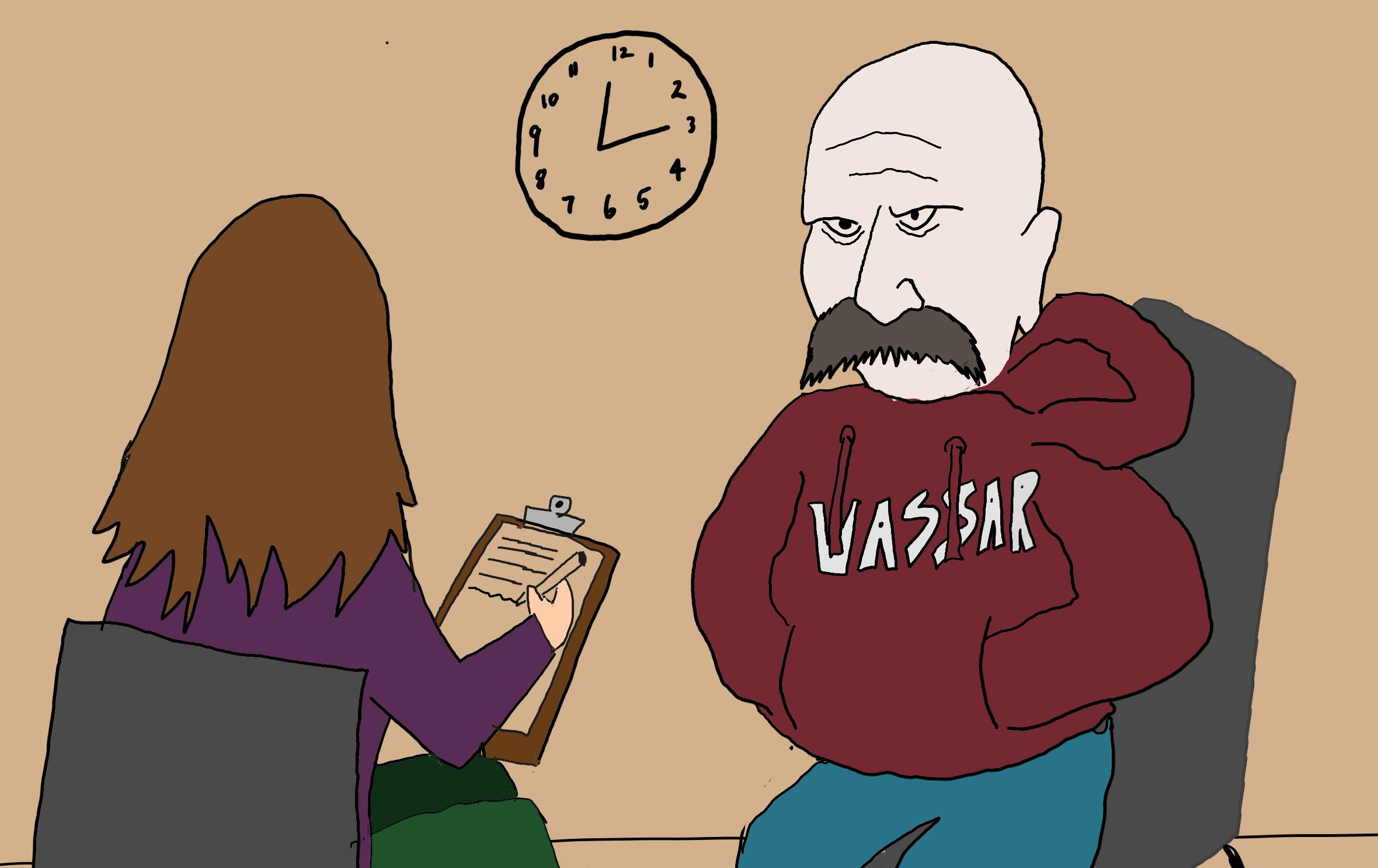
CO: I am considering HUUUUUH a correlate.
JW: That’s amazing! But of course, classes aren’t everything. Are you doing any clubs or extracurriculars?
CO: HUUUUUH I have joined the rowing team. It suits me to rise before the sun. HUUUUUH I wished to join Ultimate Frisbee but I struggled with HUUUUUH the naming of the team. HUUUUUH Nuns and Monks repel me. I am also enjoying HUUUUUH making urns HUUUUUH in the ceramics studio.
JW: Wonderful. What are your thoughts on the actual campus? I personally think Vassar is a beautiful place.
CO: Vassar is HUUUUUH truly a stunning campus. HUUUUH Its beauty HUUUUUH is comparable to HUUUUUH my own native Romania.
JW: I’m glad you feel at home. Switching gears a bit, I’d say Vassar students have a unique fashion sense. How would you de-
scribe your own personal style?
CO: HUUUUUH I am known HUUUUUH for my sweeping capes HUUUUH and hulking robes. However HUUUUH I have been meaning to get into HUUUUH skirts atop jeans.
JW: That’s such a cute look. You can totally pull it off.
CO: HUUUUUH Fang you very much. Fang. HUUUUUH Just a little vampire humor.
JW: Hilarious! What do you think about the Vassar party scene?
CO: Well HUUUUUUH the revelries at Pennsylvania State University HUUUUH are more spectacular in nature. However HUUUUUUH I do enjoy prowling the Town Houses HUUUUUH in search of entertainment. It creates HUUUUUUH a certain camaraderie among students.
JW: That’s great. Do you have a friend group here at Vassar?
CO: Yes. HUUUUH I met my friend Vlad at orientation and we have become HUUUUH quite close. HUUUUH We share an interest HUUUUUH in drinking blood and spreading plague. I have met other compatriots HUUUUUH through casual weekend… drinking.
JW: Classic. Any love life gossip? You know I had to ask.
CO: HUUUUH HA HA. I have one true dark love HUUUUH who waits for me across the sea. HUUUUUH but I am not immune to HUUUUUH the temptations this institution has to offer.
JW: Ooh, you skank.
CO (fangs out): HUUUUUH What you say?
JW: You respectable creature, you. Well, I think that’s all the time we have! Thank you again for talking to me, Count Orlok!
CO: HUUUUUUUUH It has been my pleasure.
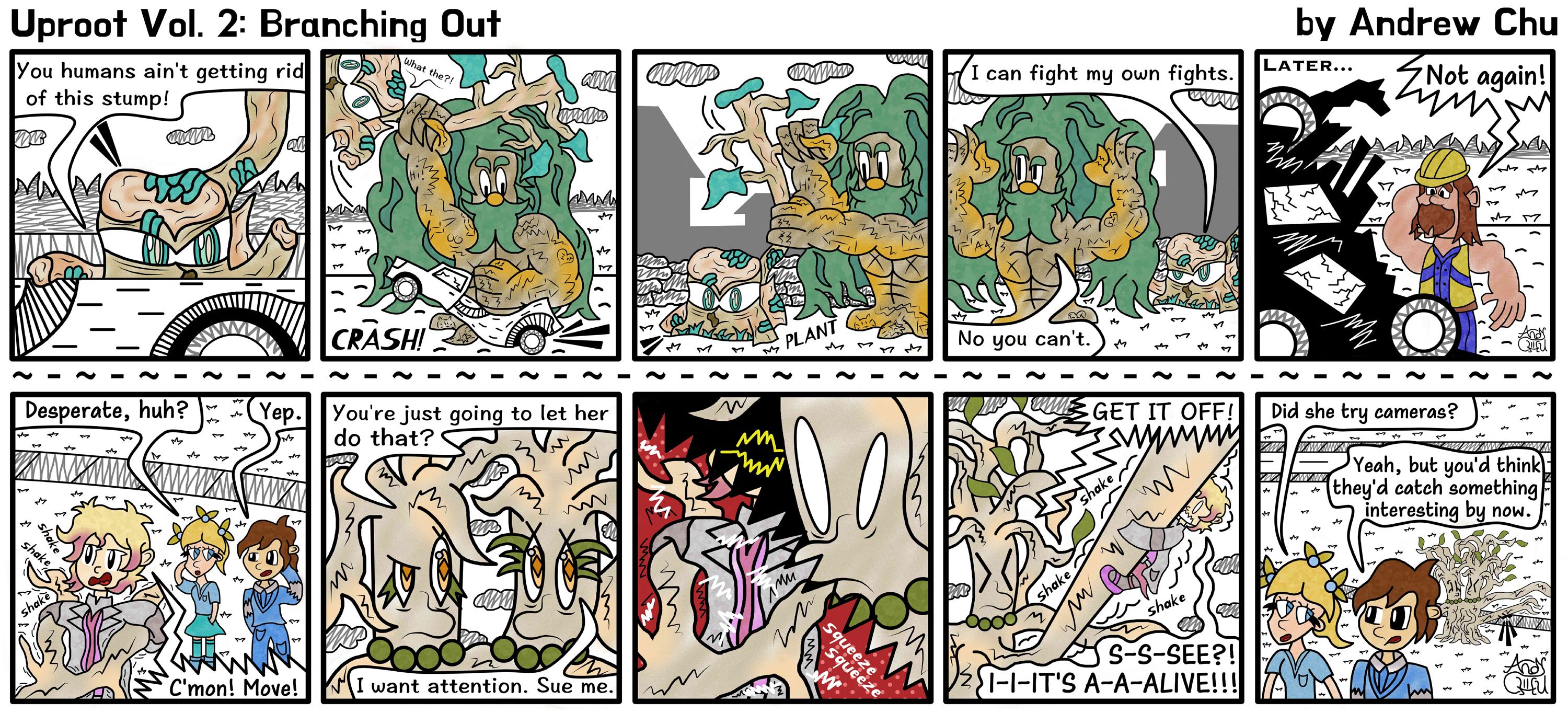
Nation shocked as absolutely nothing happens
What’sgoing on? Nothing, apparently.
The United States of America has been in shock as absolutely nothing of note has occurred in the news as of the last few weeks. Experts are calling it a “chill time” and advise that every able-bodied American “grab a beer and unwind” in these notably not-strange nor trying times. Major publications are running headlines noting this regularity, with editors and columnists alike publishing taglines such as “Guess it’s cloudy today,” and “Maybe our coffee could be better.” It’s not the end of the world as we know it, and personally, I feel alright about the whole situation. Every hammock on campus is occupied and Sunset Lake is surrounded by a line of students staring off into the distance longingly. Brewers from Noyes to Joss are reading Francis Fukuyama and agreeing that, quite possibly, history is over.
After a tumultuous few years, it has surprised many Americans that January of 2025 has become the month of really nothing of note happening. Even attempting to Google current events just loads a collage of art with the message “Go Touch Grass or Something,” written out in comic sans. This happening, or lack thereof, has piqued the interest of many notable people on campus. When asked for comment on how nothing is happening, President Bradley had one thing to say.
“Well, we could always build another hotel if we get bored.” Bradley chuckled before driving away in her Range Rover.
Hoping to get a more analytical and up-to-
date response, The Miscellany News reached out to The White House for comment.
“I don’t know, I’m just a house,” the White House said.
This comment comes after Operation Suntan, wherein all three branches of the government have taken a month-long sabbatical to enjoy the beaches of Puerto Rico. Locals report the Supreme Court Justices overturning beaches with their metal detectors and Mitch McConnell figuring out what mofongo is.
The Misc’s source for this information was a man in a cloak standing ominously in the Shakespeare Garden.
In the attempt of getting a more international perspective, The Miscellany News reached out to various Middle Eastern leaders for comment on current events. Unfortunately, the paper doesn’t have any translators so we will just assume nothing is happening there as well.
In response to the lack of anything happening, a group of students have begun camping out on the library lawn demanding nothing and just chilling out. They have titled themselves as the SJP (Students Just Playing) and were seen burning marshmallows according to various sources.
“It’s in boring times like these where us students really become the voice of the people,” said SJP leader Joe Schmoeson. “If not now, then when can we just lay around and like, I don’t know, listen to Oasis or something. Anyways, I gotta go, we’re interrupting a Board of Trustees meeting with snacks and beverages to thank them for coming to campus.”
As January comes to an end, it’s fair to say that our campus and nation are just kind of
hanging around. It remains to be seen if anything newsworthy should happen soon, and
The Misc is sure a good new movie or album will come out soon and cause some feelings
in the general public sometime in the near future. Regardless, I’m off to put up my hammock and take a nap. Maybe I’ll even go to class.

Nicholas Tillinghast/The Miscellany News.
Student possessed by ghost of Ebenezer Scrooge
Lathrop may have seen its first exciting event in almost 26 years: Interviews with hallmates reveal that house resident Madison Hayes has been possessed by the reawakened spirit of crotchety Dickensian protagonist Ebenezer Scrooge. We reached out to her hallmates for further information.
“It’s crazy,” said one neighbor. “She’s,
like, totally normal until 11 or so, at which point she puts on a nightcap and old-timey gown and starts complaining. Every time someone in the hall talks, she sticks her head out of the dorm and is all ‘Blasted youth! Why, they ought to send you all to the workhouses!’”
“It’s worse on weekends,” reported another. “I was having some friends over for a movie night and she, like, barged into the room with a candle. I swear, she literally went ‘who goes there?’ It totally ruined the
vibe of our “Kung Fu Panda 3” / “Grave of the Fireflies” double feature.”
Hayes, meanwhile, has no recollection of these nightly outbursts. “I honestly don’t know how I could have done these things. I go to bed at 11 sharp, because if I get less than nine hours of sleep I get kind of bugged out. I have had this weird craving for gruel, but I assumed that was just my way of coping with Deece food.”
There may yet be hope for Hayes, however. Late last Saturday night, she flung open
her second-floor window, and called down to the streets below, “Is there still a func at the THs?” When a kindly rugby player said yes, Hayes reportedly cried, “Then there’s still time! Here, take my fake, and go buy a six-pack of the worst beer you can possibly find.”
As of press time, Hayes has reportedly embraced the spirit of getting crunk, and vowed to live her life as if every day was six Twisted Teas deep at three a.m. on a Saturday.
Remembering the forgotten meanings of ‘TikTok’
Unless you’ve been living under a rock, you’ve probably heard about TikTok’s recent ban in the United States. The widely popular social media app has been determined a security risk by the Department of Defense. Although President Trump has delayed enforcement of the ban by 75 days, things don’t look good, with many Americans already turning to alternatives like RedNote and Lemon8. It seems like the colossal hold that TikTok had on pop culture from 2016 until now is slowly waning to its impending end. This means that we as a country can finally remember the synonyms and pluralities of the phrase “tick tock” and restore o`urselves to a pre-brain rot time. Here are some of my favorite findings from my research on TikTok alternatives:
1. Tick-tock
Gotta start things out with a classic. Of course, I’m talking about “hickory dickory
dock, the mouse ran up the clock,” which rang out with a sonorous tick-tock. The sound of a clock ticking is universal and ubiquitous. To many, it signifies dread or something foreboding, but the sound of tick-tock can also mean that class is over, or you’re playing your instrument in sync with your metronome, or you have murdered someone and you can hear the sound of their heartbeat from your floorboards. To each his own!
2. “TiK ToK” by Ke$ha Oof, maybe it’s a good thing we’re not waking up in the morning feeling like P. Diddy anymore, but this club anthem reigns supreme. It’s unfortunate that Ke$ha’s 2009 hit song has been overshadowed by TikTok, the app, but hopefully, now it’ll creep back into the minds of the public again. Ke$ha herself wrote on Instagram that “TikTok may be temporary, but TiK ToK is forever.” Guess it’s true that the party don’t stop, no, oh, whoa, whoa-oh.
3. “Tik-Tok” by John Sladek
Have you all forgotten about the seminal 1983 science-fiction novel “Tik-Tok”? Well, now you’ve remembered it. You’re welcome. The book follows a robot named Tik-Tok—named after the mechanical man from “The Wizard of Oz” books, another forgotten Tik-Tok—who gains sentience, commits violent and heinous crimes, and eventually is elected Vice President of the United States. Do we have confirmation yet on whether J.D. Vance is a robot or not?
Seems like we don’t know…
4. Arnott’s Tic Tocs
While I’m not British, I do enjoy a good biscuit, and one biscuit I am eager to try (now that I am exploring non-TikTok options) is the Tic Toc. Arnott’s Tic Tocs are circular vanilla-flavored biscuits that feature embossed clock faces and yellow and pink icing. Arnott’s is the same company that makes biscuits like Iced VoVos and Wagon Wheels, so you know they know their stuff. Now that TikTok is gone, the Tic Toc is sure to take off soon! Try saying that ten times fast.
5. Tick-tock journalism
Of course, as a journalist myself, I have to mention the tick-tock that is closest to my interests and passions. A tick-tock story is simply reported writing that’s focused on the chronological order of events. So elegant and straightforward. Not to be confused with TikTok journalism, which is full of health misinformation and AI-generated slop about how eating salmon is causing lung cancer. Remember the difference.
While I myself am not a TikTok user, I am a little saddened to see what has become of the app. Whether you love it or hate it, it can’t be denied that TikTok forced creativity and content-making back into the hands of the individual and away from mainstream media outlets. TikTok opened our eyes to the truth behind the lies of the American government and its propaganda—maybe the ultimate reason why it’s being taken down. The future of TikTok may be uncertain, but one thing is for sure: I love Ke$ha. I seriously love Ke$ha.
HUMOR
Breaking News
From the desk of Nicholas Tillinghast
Inspiring: Student buys back family’s farm with Brewer Bucks
Everything my family fought about this Christmas
Tess Foley-Cox Angel’s Advocate
If your mom is anything like mine, when you dutifully asked her what she wanted for Christmas, she heaved a sigh, and said “peace and harmony.” If you’re anything like me, you told her, “I meant something available on Amazon Prime.” Important context here: my brother, Bay, is a Tech Bro. I love him dearly. He’s also a stereotype. He went to Stanford. He lives in San Francisco. He’s been “getting really into skiing.” And, from an early age, he became the worst thing a white man can be: the devil’s advocate. So, along with Ella Fitzgerald and Mariah Carey, the soundtrack to the Foley-Cox Family Christmas involves a steady stream of passionate debate. Or, what others (my mom) refer to as bickering, whining and yelling. I’m sorry to say that though my mother appreciated her puzzle, her other gift didn’t arrive. I couldn’t provide her “peace” or any of this so-called “harmony,” but I can provide her a detailed list of where exactly everything went wrong.
1. The most soul-crushing, time-sucking
fight known to man always begins with an innocuous question: “What movie should we watch tonight?” Maybe in some families this question doesn’t involve a winner and a loser. If those people exist, I’d like to meet them. But where I’m from, this is serious business. Before you start calling me “obstinate” and “unwilling to compromise,” as many others have, know that I’m jaded for a reason. I tried yielding to my brother’s will. I watched all two hours and 58 minutes of “The Lord of the Rings: The Fellowship of the Ring” and two years later, I still don’t stop hearing about how we didn’t finish the original trilogy or “The Hobbit.” I can’t make that mistake again.
My family, if not easy-going, is invested in democratic processes, so to Robert’s Rules of Order we turned. We each posed a suggestion. We debated. We casted ballots. Some argued that for a truly democratic election, the vote needs to be rankedchoice, others argued that “this was ridiculous and it’s December 23rd can we please for the love of God just watch a Christmas movie.” But, the election was already underway. Votes were counted. A movie was crowned the winner (after, of course, it was
found that Bay had “accidentally” forgot to count a ballot). This seems like a pretty reasonable place to assume the story is ending. To everyone’s chagrin, it is not. That’s right, we hopped on the contested election trend. “Let’s watch all the trailers then decide.” It was nearly ten o’clock. My dad went to take the dog for a walk. By the time he came in, we had decided we would watch a three-hour Bollywood film no one had mentioned in the previous hour. (“Three Idiots,” five stars).
2. I think it’s worth noting that the adept among you may begin to notice a throughline of these stories: Bay. And yes, okay, maybe you have a biased narrator, but in my defense, this next one was entirely, wholeheartedly, most definitely his fault. Except for the end. But everyone knows the ending is the least important part of every story.
When the brownie batter turned out sort of gluey and smelled suspiciously of eggs, I knew who was to blame. Bay had spent “fun family baking time” scrolling on Reddit and trying to convince me to add an economics correlate. It was a pretty safe bet, although
he said he wasn’t helping enough for it to have been him. But we needn’t have argued. The timer was counting down and as soon as the brownies emerged from the oven, it became incredibly clear that it was, to my deep humiliation, my fault. I forgot the sugar.
3. While many of this year’s fights were fought loudly, others were silent. Dare I say passive-aggressive? You know when you get up from your seat and your dog steals your coveted spot on the sofa? Look, I really hate to make this comparison. I hear how it sounds, I really do… but, as it turns out, my brother’s girlfriend is like a dog. It was uncanny! Go to the bathroom: she’s in your chair. Want a drink? A snack? I’d think twice, unless you’re ready to eat it while sitting on the floor.
In case your patience, like my mother’s, is wearing thin, here’s a brief overview of the rest of this season’s hot topics: what constitutes a HIPAA violation, eggnog—God’s nectar or curdled piss— and, like every year, the rate at which gifts can be opened and admired before moving to the next person’s turn. Here’s to trying again next year!
Planning a group project with nine awful people
Ciara: My horse has suddenly fallen ill.
Brandon: My horse has also fallen ill tonight.
Monday at 10:24 p.m.
You: So, the project is due next week. I guess that means we should meet up soon?
Melanie: I can do any day this week :)
Hector: Thursday Evening?
Melanie: I have a lab from 6-12 that night :( Sorry.
You: What about Wednesday in the evening? Like 7?
Logan liked your message. Melanie liked your message. Ciara liked your message. Hector liked your message. Brandon liked your message. Esperanza liked your message. Aubrey liked your message. Brian liked your message. Henry liked your message.
You: Okay. It seems like that works.
Wednesday at 6:49 p.m.
Melanie: Omggggg. I’m so sorry guys! My horse has fallen ill :( I can’t make it tonight.
Ciara: Omg! I hope your horse feels better :( Mine is in perfect health.
Melanie: Let me know if there is anything I can do to help.
Ciara: ok
Aubrey: Hey guys– I’m in Australia right now. I don’t think I can make the meeting. I can join on zoom actually wait I can’t because we’re deep in the woods. Message me the deets. Actually no I’m worried my phone’s gonna die. Send a bird maybe?
You: A bird?
Aubrey: Yeah the ones that you put the little message on.
You: Like a carrier pigeon?
Aubrey: Yeah.
Melanie: There must be something going around :(
You: Can anyone else not make the meeting?
Brian liked your message
Esperanza: Yeah I don’t think I can make it. I’m kind of booked up this month.
You: The Whole Month?
Esperanza: Yeah. School stuff. You know how it is.
Logan: One of my horses (yes I have multiple) seems like he’s coming down with something. Seems like he could use some company. If you really want me to go to the meeting I’ll try to be there.
Henry: Dude. I’ve known you for like three years. You’ve never mentioned owning horses. What kind of horse is it?
Logan: Brown
Henry: Brown?
Logan: Idk. It’s a mutt.
You: Please try to come to the meeting.
Dylan: No I don’t think I will. Too much negativity here.
Henry: Agreed.
Hector: I can meet.
You: Ok, I guess me and Hector will meet and then fill the rest of you in.
Hector: Okay!
Wednesday at 7:05 p.m.
Hector: Hmmm. Actually can’t go to the meeting anymore. Just got struck by lightning. They’re saying I should go to the hospital. All you, boss. Leave Chat?

HOROSCOPES
Emma daRosa Lowercase is Intentional

ARIES March 21 | April 19
All your neighbors can hear you having really loud sex. You are literally RUINING everyone’s life right now. I hate to be the bearer of bad news but these walls just aren’t soundproof and your horrific boinking noises are painfully audible. My recommendation would be to just like chill out. Maybe watch a movie tonight instead.

TAURUS April 20 | May 20
You’re going to face some terrible temptation this week. I know you want more than anything to get so so cozy and ignore your readings. It would probably feel really good to be like “It’s fine! I can just get up early and read that before class!” but you and I both know that’s a lie. You should do the readings. If you don’t, the stars predict that you’ll fail out and die alone. Do you really want that?

GEMINI May 21 | June 20
Someone is going to try to convince you that the Deece fish is actually really good this week. They’re gonna make all kinds of promises about the seasoning or the sauce or whatever, but you need to remain strong. Everyone knows that things that live in water belong in the water, not in anyone’s mouth. To be safe, I would make sure to start every meal you have with people this week by screaming “I WILL NOT BE EATING ANY FISH AT THIS MEAL” as loud as you can. Do this even if fish isn’t being served, you never know what could happen.

CANCER June 21 | July 22
It’s time to take that campus crush to the next level. Valentine’s Day is coming up! Next time you see that special someone, the best thing to do is play hard to get. As soon as you see them, run as fast as humanly possible in the other direction. Maybe throw in some gagging and retching noises so they think that they completely disgust you. That’ll definitely get their motor running!

LEO July 23 | Aug. 22

VIRGO Aug. 23 | Sept. 22
This is your week baby! You might face highs and lows and ups and downs, but don’t worry, everything is going to turn out exactly as you want. At the end of the week, you, my friend, are going to win an ALL EXPENSES PAID TRIP TO THE NEAREST RAINFOREST CAFE. Have so much fun!!!!!!
I think you should walk around naked this week. Just like chill out, lose your inhibitions. It’s super fun to be naked and it’s super fun to walk around, so that would be a really good combination. Maybe you’ll start a trend! Someone’s gotta be first.

LIBRA Sept. 23 | Oct. 22

SCORPIO Oct. 23 | Nov. 21
You’ve gotta let the Duolingo streak go. I know that you’re really proud of it, but it’s getting embarrassing. Just take a day off, see how you feel. It’s honestly bordering on addiction. There’s no need to be so freaky about it.
You, on the other hand, aren’t taking Duolingo seriously enough. All of your friends are talking behind your back about your lack of dedication. It’s time to take it to the next level. Just do it while you’re on the toilet or whatever! Just take something seriously for God’s sake.

SAGITTARIUS Nov. 22 | Dec. 21
It is soooo much fun to scroll Reddit all the time but you should try to scroll Reddit less this week. Maybe like go on Reddit for 19 hours instead of 20. Imagine what you could do! That’s a whole additional hour that you can dedicate to Instagram reels.

CAPRICORN Dec. 22 | Jan. 19
You’ve gotta stop downloading all the weird game apps this week. I know that they’re all full of ads for games that are so fun. The ads let you play a little bit, you have the best time, you want to download it, but you know the truth. It’s Candy Crush. It’s just Candy Crush. They’re all just Candy Crush.

AQUARIUS Jan. 20 | Feb. 18

PISCES Feb. 19 | March 20
You’re gonna get into a fight with someone who takes the rest of the Deece berries at breakfast. Like a huge amount, clearing the whole bin, scraping until they get the very last one. I know it’ll fill you with rage, but you should just try to stay ca— you know what? Nevermind. You’ll be in the right.
You need to spice up your life a little bit. There are lots of different things you could do, but there’s one thing that would really get you out of this rut. You should steal one of the rowing team boats and take it onto Sunset Lake. It would be so fun, you can do the Washington crossing the Delaware pose and stuff!
OPINONS
Second Trump administration threatens free speech
Jacques Abou-Rizk Contributing Editor
On Monday, Jan. 20, Donald Trump assumed the Office of the United States President for a second time. His enthusiasts—and his established circle of tech CEOs—praise the First Amendment. In 2022, Tesla and SpaceX CEO Elon Musk, now a prominent supporter of Trump, acquired X, formerly Twitter, for $44 billion in the name of ending censorship, according to The New York Times. But beyond their public discourse is an underlying threat—a warning to journalism and writers across the country.
TikTok CEO Shou Chew is the latest CEO to conform to the new administration. Throughout the confusing week where it was unclear if TikTok would be banned, the app went dark for U.S. users for less than 14 hours, before returning to full use with a “thank you” message for then-President-elect Trump, as reported by The Wall Street Journal. On Jan. 20, Chew appeared in the Rotunda at Trump’s inauguration.
Just weeks ago, Meta CEO Mark Zuckerberg released a video announcing that Instagram and Facebook would be ending their professional fact-checking policies, revealing the so-called “Real Mark.” He also has started to roll back DEI and LGBTQ+ protections at Meta, according to NBC. Additionally, Meta plans to introduce community notes to its social media platforms, similar to X, where readers can add context to posts online. Business Insider argues Zuckerberg has done all this to appease Trump.
And, of course, Elon Musk. The wealthiest person on Earth. Spending more than a quarter-billion dollars to help elect Trump, according to CNN, Musk is now set to run a newly established United States Department of Government Efficiency (DOGE)—all while his companies, including SpaceX, receive billions of dollars in federal contracts. According to the BBC, DOGE will not be a formal government department. Rather, it is
set to serve as an advisory board to the president to review government spending and regulation. As The New York Times writes, “That would essentially give the world’s richest man and a major government contractor the power to regulate the regulators who hold sway over his companies.”
But Musk has been pleasing Trump for quite some time. When Musk purchased Twitter back in 2022, he reinstated Trump’s banned account, according to The New York Times. Soon after, Musk was donating to Trump’s campaign and appearing on stage in a MAGA cap.
Despite the supposed haven for free speech on X, Musk has faced backlash and accusations of censoring the accounts of conservatives who disagree with him, according to NBC News, and for an algorithm that aimed to contain negativity on the site, according to NY Post.
These recent developments on social media are not in the name of free speech: it is in the name of appeasing a leader who threatens those who resist him. NPR reports how Trump has said he would jail reporters and strip major television networks of their broadcast licenses if he does not like their coverage.
According to the International Women’s Media Foundation, nearly one-third of journalists have reported being threatened with or experiencing physical violence while working. A Colorado reporter, according to The Guardian, made headlines in late December 2024 after he was attacked while being asked, “Are you even a U.S. citizen? This is Trump’s America now!”
Google is even moving forward to change the name of the Gulf of Mexico to the Gulf of America on Google Maps in line with Trump’s recent executive order, according to Reuters.
Perhaps most concerningly, it is not just tech CEOs falling in line with Trump. Major networks, most notably ABC News, are doing everything possible to find their way back on Trump’s good side. Trump sued ABC
for defamation after anchor George Stephanopoulos’s incorrect assertion that Trump had been found liable for rape in a 2023 civil case in Manhattan, according to The New York Times. Rather, Trump was liable for sexually abusing writer E. Jean Carroll, not for New York’s narrow legal definition of rape.
In December 2024, ABC News settled the case for $15 million, a historic and troubling sign. Despite several media law experts arguing that ABC could have continued to fight given the high threshold for defamation of public figures, some critics argue that “ABC and parent company Disney are bowing to Trump for craven political purposes,” according to CNN. Already, “Trump, who has called the press the ‘enemy of the people,’ is threatening to use legal and criminal levers to ‘straighten out’ journalists,” Politico reports.
And while we know Trump’s bark is far worse than his bite, the threat is real. According to AP News, “It’s not just criminal
prosecutions that worry those who have crossed President Donald Trump. There are more prosaic kinds of retaliation: having difficulty renewing passports, getting audited by the IRS and losing federal pensions.” Those with power and money will do anything to protect themselves.
As Tech CEOs, business leaders and major news leaders—all the world’s richest people—“bow” to Trump, we worry about what comes next. Beyond bowing to Trump, they also ironically and disturbingly represent a new form of populist expertise through their supposed validation and endorsement of “free” speech. In Sen. Bernie Sanders’ words, “We are moving rapidly into an oligarchic form of society. Never before in American history have so few billionaires, so few people, have so much wealth and so much power.” Despite their shouting, Trump and his allies are no defendants of free speech. The technology and the news we surround ourselves with are quickly shifting away from the freedom and diversity we demand.

Stop treating Trump like a celebrity
Since his victory, President Donald Trump has been proposing to not only make America greater, but bigger. In response to backlash from raising trade tariffs to 25 percent, Trump has frequently suggested that Canada become the 51st U.S. state. According to NBC, shortly after the death of former President Jimmy Carter, Trump expressed interest in returning the Panama Canal to U.S. control to curb China’s use of it, and would not rule out the use of military force. Greenland is also apparently on his list, and he has even proposed renaming the Gulf of Mexico, the “Gulf of America.” What is going on here? Will we really be adding stars to our flag?
The answer is no. Trump is unlikely to do these things. Annexing three allied countries would be so outrageous that even Trump’s allies in Congress would not fully support it. Trump himself tends to speak in exaggerated ways, promoting nationalism and his own popularity. While it is easy to dismiss these bizarre suggestions as “Trump being crazy,” I do believe this behavior exposes certain strategies that the seemingly unpredictable president utilizes.
If anything, these statements could be a diversion. In the week before he made these statements, Trump was officially sentenced as a convicted felon. NBC and other outlets have
also documented that Elon Musk and MAGA’s anti-immigration wing were bickering over the idea of letting in immigrants for tech work positions through the H-1B program. Statements about taking over Greenland and the Panama Canal have conveniently drawn the lion’s share of attention from both supporters and critics of Trump.
These promises, as unlikely as they may be, have topped headlines. The week when Trump made these statements, national news was already scrambling to cover the death of Jimmy Carter, two terrorist attacks on American soil, and a series of destructive wildfires in Southern California. Despite all these things, they still made space for Trump’s remarks. When you think of Trump, I would bet that the first thing that comes to mind would be his quotes. In 2006, he said on TV that he would date Ivanka Trump if she was not his daughter. In 2017, he called the leader of the nuclear-armed North Korean Regime “Rocket Man.” In 2024, he falsely claimed that Haitian immigrants were eating dogs. We may disapprove, but we still are fascinated by these insults and petty rivalries in the same way we are with celebrities. These infamous quotes grab our attention and do reveal some of his character and beliefs. But they do not give us a tangible picture of his policy plans, how they have worked in the past, or their consequences. When the media prioritizes Trump’s antics over Trump’s actions, they are entertaining
their viewers instead of educating them.
According to the Pew Research Center, many Trump voters were concerned about higher food prices under Biden and made their decisions accordingly. This is true, but inflation soared because of the 2020 pandemic, a crisis that experts say Trump downplayed and ultimately mishandled. And even if that is in the past, Trump’s major campaign promises are mass deportation and trade tariffs, which according to the Tax Foundation, will hurt the economy and raise prices, not lower them. People who associate Trump with low prices have not been informed about this link because they do not have a roadmap for the causes and effects of Trump’s decisions. Why would the news bore us with charts and figures when they could instead rave about him saying it is cool to inject bleach?
It is common knowledge how fanatical Trump’s followers are towards him. He knows how to play on their emotions and use charisma to create loyalty. But he has another bag of tricks for his opponents and critics: he shocks them. Every outrageous thing he says will be well-documented. Even people and media that dislike him will divert more attention to the remark, and less to the issue itself. Trump gets millions worth of free press this way and can control their focus using nothing but his big mouth.
Trump now exists in a media environment that greatly benefits him. Critics are
compelled to act shocked at his antics, without painting a meaningful picture of what Trump’s leadership has been doing over time. Meanwhile, Trump’s outlandish remarks do not bother his supporters. In fact, many of them take pride in offending the sensibilities of the “fake news,” who they resent and deem an elite class. Liberal media’s favorite word to describe Trump is “unpresidential.” But no matter how unpresidential he acts, Trump is still the president. He still holds the powers and responsibilities of the president. Trump’s critics should scrutinize his governance and ability to create policy that benefits the country. When his actions have negative consequences, that impact should be documented, not just his words by themselves.
In the end, viewers of the news seem to focus more on Trump’s personality and drama, like we would with a celebrity. The more time we focus on his outbursts, the less we focus on his actions as a leader. Trump may be exaggerating when he talks about annexing our neighbors. That does not mean that he will not enact tariffs and strain relations with our allies. That does not mean he will not push agendas that, while less dramatic, will still make life worse for people, domestically and abroad. If one wishes to criticize Trump effectively, one should look for the meanings and actions behind his statements. We should make sure we are putting the policy over the celebrity.
OPINIONS
Can assisted suicide be ethically justified?
Zach Silbergleit Guest Columnist
[CW: This article makes mention of suicide.]
Iremember when I was 10, my dog was put down. He was 16 and lived a happy life, but it was clear he was suffering. When this happened, my mom assured me of several things, including that his death was quick and painless, and that had he not been put down, he would have only suffered and been miserable for longer. At the time, I did not think further of it, but now that I am older—and a philosophy major—I have lingering thoughts about this. Many of us can relate to having pets or relatives that are not doing well and stopped fully enjoying life a while ago. The idea that we have the scientific/technological ability to peacefully and painlessly end their lives presents a serious ethical question: Can assisted suicide be ethically justified?
Answering this question is difficult and varies based on one’s individual moral philosophy. If you fundamentally believe in free will and respecting one’s choices, then assisted suicide is clearly ethical. However, if a core component of your moral philosophy is a belief that life must be protected at all costs, then assisted suicide would clearly be in violation of that. This leaves the answer to our question as a big fat “It’s complicated.” I cannot hope to back up a claim that assisted suicide is always or never ethical. There are simply too many variables. However, I do believe I can defend the claim that if certain conditions are met, assisted suicide would be ethically permissible.
The first condition is that death is somewhat imminent for the person. The most obvious example is that they have a terminal illness. In other words, you must not be “killing” the person and instead be letting an
The
already dying person die on their own terms. The second condition is that the death that would occur without intervention must be a painful one. If your illness is slowing you down and will result in you at some point falling asleep and never waking up, that is not painful under this condition. What would be painful in this regard is the later stages of a disease like ALS. The third condition is that the person who wants assisted suicide must consent without influence. If they meet the conditions to permit assisted suicide, the decision must be theirs and theirs alone.
There are also key conditions regarding what there cannot be. The first characteristic that is ethically prohibited is commodification. Assisted suicide is to be restricted based on the conditions of the previous paragraph. Money can play no role in this. If assisted suicide becomes based on money, it ceases to be based on morals. If it costs, say, $10,000 dollars to go through with an assisted suicide, that creates a new condition based entirely on financial status. Putting a price tag on it would restrict it from many people including some who meet the previous conditions. An ethical case for assisted suicide should not be tainted by inequality. The other attribute that one cannot possess in order to have an ethical assisted suicide is hope. In other words, for it to be ethically permissible to kill someone (who wants to be killed), it must be clear that they are not truly living anymore.
To demonstrate how assisted suicide is always ethical under these conditions, I will prove that it is ethical under two very different moral philosophies. The first is utilitarianism. Broadly speaking, utilitarianism is a consequentialist (morality of actions is based solely on the consequences of those actions) moral philosophy that focuses on examining how actions increase pleasure and decrease pain. The morality of all actions is deter-
mined by examining how much the action does or does not do these things. If a person is greatly suffering and the only way to truly ease their pain is painless assisted suicide, then under utilitarianism, assisted suicide is clearly ethically permissible. Furthermore, I would argue that under utilitarianism and assuming the required conditions including consent are met, assisted suicide is ethically mandated since not doing so would only increase their pain.
Another prominent moral belief system is deontology ethics. The example I will use comes from Immanuel Kant. Specifically, what Kant calls the categorical imperative was originally formulated as “Act only according to that maxim whereby you can at the same time will that it should become a universal law.” One could think of this as being similar to the Golden Rule, which is to treat everybody the way you would want to be treated. Under the categorical impera-
tive, killing people would be wrong because you would not want it to be a universal law that everyone can kill other people. However, I would argue that assisted suicide with the conditions I have laid out is ethical under the categorical imperative because I have no issue with it being a universal law that assisted suicide can be permitted—though is not required—if all the outlined conditions are met. Overall, assisted suicide is a very complicated phenomenon that raises several important ethical questions. I believe that many of these ethical questions can be resolved if several important restrictions and requirements are put in place for those who might seek out assisted suicide. While everyone is entitled to their own convictions about whether or not they view assisted suicide as right or wrong, I believe that if the aforementioned conditions are met, assisted suicide is ethically permissible for all who may seek it out.

vibe shift and how to combat it
After the MAGA victory in November and President Donald Trump’s inauguration just last week, ignoring the changing rhetoric and consensus on social issues has been impossible. From Trump’s popular vote victory to Mark Zuckerberg’s rollback of DEI (Diversity, equity and inclusion) policies, accompanied by his call to “celebrate aggression” in workplaces, to Elon Musk’s public Nazi salute, our cultural landscape appears to be shifting toward a more overt and emboldened form of right-wing intolerance.
The “Vibe Shift,” “Culture War” and “Manosphere” are terms I have seen used to refer to this right-ward shift in the social Overton window. Sadly, it appears that the Progressive Left–the movement made up of those who fall slightly to radically further Left on the political spectrum than the average liberal–has failed to cement a meaningful understanding of gender theory and anti-racism into the public psyche. While significant progress has been made in LGBTQ+ acceptance, the MeToo movement, and anti-racism advocacy in the past decade and a half, the forces against such progress have increasingly gained traction among the American public. The Left’s efforts to impact sociopolitical culture have not made much of a mark beyond marketing, social media optics and DEI corporate policy. If the Left wants to be taken seriously, and have overt hatred become shameful and unanimously ridiculed again, there must be a new angle of attack.
I firmly believe in the power of cultural
exchange, diversity and acceptance. I also firmly believe that these principles—as genuine ends and not practical means—are absent from the American right. Despite how hollow, and at times, ineffective mainstream liberal policies may seem, I applaud their attempt at promoting awareness of the horrors of violent intolerance of the past. The Right wants to erase the history of American racism, subjugation and genocide, deport millions of loved ones, control who has bodily autonomy, and implement elements of theocracy. This is a scary time, and I often feel my heart beating rapidly when I watch or read the news. However, we cannot lose sight of our values and must stay firm even in times of hardship.
I have thought up a few practices you can commit to intellectually resist the vibe shift and help others resist its strategies and tricks. These practices are not meant to be dogmatic or exclusive to the Left but to help alleviate the illness of intolerance and judgment that we have all been infected with.
1. Open your mind: The first step in fighting ignorance is to fight your own. Educate yourself on other countries, foods, religions, philosophies, cultures, histories, etc. Learn how diverse our paths are so that you can become accustomed to the truth that we are all different, and that is ultimately okay.
2. Calm down: The current stereotype of the Left is something along the lines of whiny, loud young people living in ivory towers. If you are going to be more tolerant, that applies to people with differing, and even bigoted viewpoints. Instead of automatically getting offended by acts of bigoted speech
or behavior, even if they are directed at you, choose action by explaining to the person that what they did was insensitive and why. I know this restraint in the face of pain is hard and potentially idealistic, but the Left would go a long way in changing the behavior that leads to echo chambers and hostile conversations. The Left needs to focus on the possibilities of rehabilitating bigots instead of calling them out and ending there. We cannot “pearl clutch” at every instance – though, I think examples like the Elon Musk situation are the appropriate times for pearl clutching.
3. Eat your veggies: Read up on right-wing strategies for stoking the flames of racism, transphobia and other bigoted philosophies so you can identify them and know how to help others avoid them. Whether they be absurd headlines about transgender Olympic athletes or anti-white school lessons, there is often some truth that is being obscured by racism or transphobia to increase engagement in the news cycle.
4. See through the lies: Know when the Culture War is being used as a distraction to rile up people towards something stupid. Avoid these “rage bait” discussions on representation in media—think the casting of the live-action “Little Mermaid”—or other points of dead-end public outrage so you can save your energy.
5. Do not die on any hills: I, as a leftist, have found myself too deep in a defense flawed policies like DEI or Affirmative Action when in arguments with the “anti-woke.” While these two policies have provided great aid to marginalized people, they are not the end solution to racism. I have experience with
boring cultural competency training and ineffective DEI directors. The underlying motives and philosophy of these policies are good, but the societal impacts do not stick in the minds of many people. To save you the trouble, I recommend you only defend an idea or policy if its real effects align with YOUR values, and not because its philosophy vaguely aligns with your political camp. This practice involves deep analysis of what you believe in and what you are arguing. You need to know that such policies are not the ends of our mission but just the pragmatic means.
I hope that if enough leftists, or simply just people who want to see a kinder and less hateful world, adopt these practices, the Progressive Left can reinvent itself into something more effective and disciplined. These practices can help dispel the misinformation surrounding so-called “Wokeism” and resist the impending far-right assault on our culture. I want to see a Left that focuses on providing space and comfort to minorities instead of using their identity for optics or continuing their shame and discomfort. I want to see a Left that is willing and able to keep a level head when more and more terrible news comes out in the next few years. I want to see a Left that has respect in the American collective consciousness and has minds that can dispel the hatred that is infecting more and more people.
I am not trying to invent anything new, I am just adding a course correction to inspire you to aid in the intellectual resistance against the MAGA and Anti-Woke movement.
Pittsburgh has given up on Mike Tomlin: I know why
Ben Vinson Guest Columnist
“We’re not going to apologize for winning.” This has been the mantra of the Pittsburgh Steelers for 18 years under Head Coach Mike Tomlin, and upon rudimentary inspection, it seems pretty valid. Since 2007, his first year in the position, the Steelers have never had a losing season— meaning they never lost more games than they won—which has been pretty pleasing for fans. In Pittsburgh, where Steelers fandom is often compared to being devoted to organized religion, this record has only strengthened fans’ care for the team. The franchise is generally regarded as one of the greatest in the history of the National Football League (NFL), being tied for the most all-time Super Bowl victories and having the highest winning percentage of any franchise since 1970 (the year the Super Bowl was created). Tomlin’s regime has lived up to these standards for the most part, making the playoffs two-thirds of the time, appearing in two Super Bowls and winning one. For many other franchises, this coaching resume would exceed expectations, but in the Steel City, where great things are expected yearly, this is not so.
Tomlin is a lover of making eccentric quotes—nicknamed “Tomlinisms”—and it is pretty widely beloved by all of Steeler Nation. “The standard is the standard” is the most well-known—and redundant—with him repeating it whenever necessary to recenter the team’s historic greatness regarding whatever issue the team is facing. Despite this attitude and recognition of what they have to live up to every game, the Steelers have done little more than just enough to win in recent years. Both of Tomlin’s Super Bowl appearances happened within his first four years as head coach, and that is no coincidence. He inherited the team built by his predecessor, Bill Cowher. With future Hall of Fame quarterback Ben Roethlisberger playing in his prime alongside what was considered the best defense in the NFL, winning came easy. His top three years in point differential (points scored minus points allowed) all happened within this time, with the only exception being the year after their 2008 season Super Bowl victory, during which several defensive stars missed most of the season due to injury.
As the team evolved and its best players retired, Tomlin managed to keep it star-studded, with two of their current defensive linemen—Cameron Heyward and T.J. Watt—being guaranteed Hall of Famers after they retire. Despite retaining talent, the scales have tipped the other way. Tomlin’s winning record streak has remained, but the team’s point differential across the last four years has been -80. Other teams with this differential generally lose nine or ten games per season, so it is impressive that Tomlin has always been able to find a way to succeed, but it looms as a bad sign for their long-term success. It is easy to blame this on the uncertainty at the quarterback position during this period, but resolving position issues is the coach’s responsibility, and Tomlin still has not figured it out. The reality is, the standard has just degraded. Late in the season is where Steelers fans’ expectations rise to their highest level, and that is not unwarranted. No matter how well the team did early on in the season, fans know that anything is possible for Pittsburgh, who achieved their 2005 Super Bowl victory (under Head Coach Bill Cowher) despite them being the lowest seeded team in the playoffs that year. The most important thing for postseason success, though, is get-
ting hot late in the year, and Tomlin knows this very well. In 2009, he famously said, “We will not go gently. We’re gonna unleash hell here in December, because we have to. We won’t go in a shell. We’re gonna go in attack mode, because that’s what’s required.” The problem is, the only hell anyone in Pittsburgh has seen for nearly a decade is the one they are living in. In five of the last seven seasons, the Steelers have lost three or more games in a row after Thanksgiving, with this year’s horrendous streak extending to five games. This is bad for any NFL team, but for such a successful franchise with a coach who wears his 18 consecutive winning records as a badge of honor, it is uniquely pitiful. Even more so is what has followed: the postseason.
In the playoffs, the Steelers of recent years have been entirely pathetic. On each side of the ball, players have failed to step up, and the statistics tell the story best. In their last six playoff games, the Steelers are 0-6, with an average point differential of -14—two touchdowns. Again, this is a horrible thing to see, but droughts like this have happened at some point for a lot of teams and are usually overcome without much fuss. It gets worse, though. In these six games combined, the Steelers have been outscored by a total of 73-0 in only the first quarter. There is just no excuse for this. Almost all of the aforementioned point differential happens almost immediately after kickoff, and after that point the team is just gasping for air. In the past decade, the Steelers have consistently had a top-ten defense, allowing less than 20 points per game across the last seven seasons, but the moment the playoffs come around; that number jumps up to almost 39 points per game.
Something is fundamentally wrong with the way the Steelers are being run, and with Tomlin’s control over the team extending beyond that of most head coaches, much of the blame falls on him. He is a defensive specialist that operates the Steelers under an old-school formula, preferring to run the ball and rely on the defense to make plays and force turnovers. This worked for decades and was what allowed the team to be so successful throughout its history, but as the game of football has evolved and passing has become less risky, conservative play simply does not work the way it used to. Teams know that the Steelers run the ball over half of the time on first down and thus focus the majority of their defenders on stopping it specifically, so it rarely goes for more than just a couple of yards.
Tomlin may not call the offensive plays himself, but he has consistently hired people who agree with his style of play, and whenever things go awry, he is more than happy to punt the ball away and rely on his defense again. This is one of the precise reasons they have struggled so much in the playoffs. The playoffs pit them against exclusively good opponents that are playing their most aggressive football of the season, and somehow, every year, the Steelers are shocked when other teams beat them with ease. Even by the second half of these playoff games, when the Steelers finally start to utilize their full arsenal to mount a comeback, they are incapable of fully letting go of their conservatism. In their recent playoff loss to the Baltimore Ravens, they managed to turn the game around in the second half and scored two quick touchdowns, but they were still down 14 points and were unwilling to attempt the risky plays required to overcome it. They punted on fourth down on their second-to-last drive in that game, effectively sealing it for the Ravens, which is just unacceptable in the playoffs. Rath-
er than go for the long first down on what they knew would almost certainly be their second-to-last possession while down two scores, Tomlin elected to punt both the ball and the season away. He did the same while attempting a comeback during several of the other games in their losing streak at the end of the season, even when it was a mere fourth and one. Late in their games against the Chiefs, Bengals, Eagles and in their other loss against the Ravens, Tomlin elected to punt instead of attempting to win. Routinely throughout the season, when faced with adversity, Tomlin has just given up. What is even the point of playing if you are not willing to take risks when behind? It is as if he would rather lose by a little than make a risky play that would either give them a chance to win if they convert or result in them almost certainly losing by a larger amount. Tomlin insists that “there’s a fine line between drinking wine and squashing grapes,” but he is not doing either.
Outside of these in-game issues, Tomlin has not done much better. There is no denying that, despite their 10-3 start to the season, the Steelers had large personnel issues. They had very poor depth at the wide receiver position, and for once, contrary to his history of not utilizing the trade block, the Steelers sent a fifth-round draft pick to the New York Jets for tall, vertical-threat wide receiver Mike Williams. This was a great decision, but the issue came in his utilization. Even though he played in all nine games after the trade, he was rarely on the field. He only was thrown to 13 times, but made the most of it with nine catches for 132 yards and a touchdown. It seemed like he made exceptional plays every time he was given a chance, but for some reason, it almost never happened. Even worse was the situation with the cornerback position, which was the team’s major place of concern before the season started. They played decently well early on, but after injuries began stacking up midseason, it was clear they needed help as well. Tomlin did not agree, and they paid the price. The team allowed more and more passing yards as the season progressed, and once the losing streak rolled around, teams sliced through them like butter with a warm knife. Tomlin said a few years back that “when you have red paint, you paint your barn red,” but that just is not a productive way to think about
this situation. With the wide receivers, he got a different color paint in Williams but painted the barn red anyways. And with the cornerbacks, he started running out of paint entirely but decided not to replace it. Earlier this year, he also said, “I can’t give you all the ingredients to the hot dog… you might not like it,” but, again, I cannot say it matters. No matter what there is in this metaphorical hot dog that I have not seen, many of the ingredients I have seen are just inexplicable—and honestly, pretty unsavory.
Tomlin may not apologize for winning, but it does not look like he will do so for losing either. The standard is not what it used to be in Pittsburgh, so what do they do? Tomlin will almost certainly be a Hall of Fame coach once he retires, and I would say that is well deserved, but sometimes things get stale. People get complacent. Perhaps if he was with another team, he could find a way to succeed in the playoffs again. The same goes for the Steelers. For such an ever-talented team, there are dozens of coaches who would happily leave their positions for this one, and I have no doubt that this team is capable of winning a playoff game or a few with better coaching. Despite this, the Steelers are giving him at least one more season in the lead, and things likely will not change almost at all, given that both the offensive and defensive coordinators are returning as well. On this season of the Max show “Hard Knocks”—which gives fans an inside look into NFL teams—Tomlin lectured his players about how it is important to take a few steps back and reevaluate the way they approach their everyday actions since this is not their job, but their career, and I think he could learn a thing or two from this as well.
Rather than believing that it is his job to always have a winning record and keep the Steelers as a team that is always kind of in the playoff conversation, he needs to understand that this is his career as well, and if he fails to live up to the standard he is always talking about, it will end abruptly. Football has been kind to Mike Tomlin in the past, with him frequently finding the craziest ways to win, and it is about time that he apologizes—not for winning, but for just winning. If he cannot do that, as much as I (a big fan of his) hate to say it, his future in football will be short.

Brewers: Ballin’: Desai leads Brewers to 6-0 start
Our goal with Brewers Ballin’ is to feature Vassar athletes who starred for their team the week previous to publishing. If you would like to nominate an athlete, please email hfrance@vassar.edu.
Brewers Ballin’
Name: Armaan Desai
Year: Sophomore

Team: Men’s volleyball
Stats: Armaan Desai has been a critical component to the Brewers’ red hot 6-0 start to the season. Desai’s stellar play during the opening weekend of the season was enough to garner two accolades, as the sophomore was named to the Clash at Kean All-Tournament Team and to the FrogJump Team of the Week. With 32 kills thus far on his sophomore campaign at an efficient .491 clip, Desai is a matchup nightmare for opponent defenses. Notably, against top-20 ranked Nichols College, Desai lit up the Bison with 13 kills at an impressive .478 hitting percentage. On the defensive side of the net, Desai leads the Brewers with 13 blocks.
Statement: “After losing in the national championship last year, we had a lot of questions going into this year. We lost our 2 All-Americans and 4 members of our starting lineup, but what makes our team special is our depth and everyone’s ability to play a contributing role to our success. This season, we are going to take it one game at a time. We are going to continue to execute our jobs on the court while lifting each other up as teammates. We know we can reach the same heights as last year - and hopefully finish the job this time.“
Recently in Vassar Brewers sports
Men’s Volleyball Starts Season 6-0
After falling in the national championship in last year’s NCAA tournament, the Brewers are back for blood, beginning their season with a strong 6-0 start.
Men’s & Women’s Fencing Sweep
Both the men’s and women’s fencing teams earned first place finished at the Matt Lampell Invitational.
Women’s Basketball Keeps Winning
The women’s basketball team is 7-1 in their last eight games, with strong performances from McDermed, Regan and Gelb fueling the Brewers to their strong record.
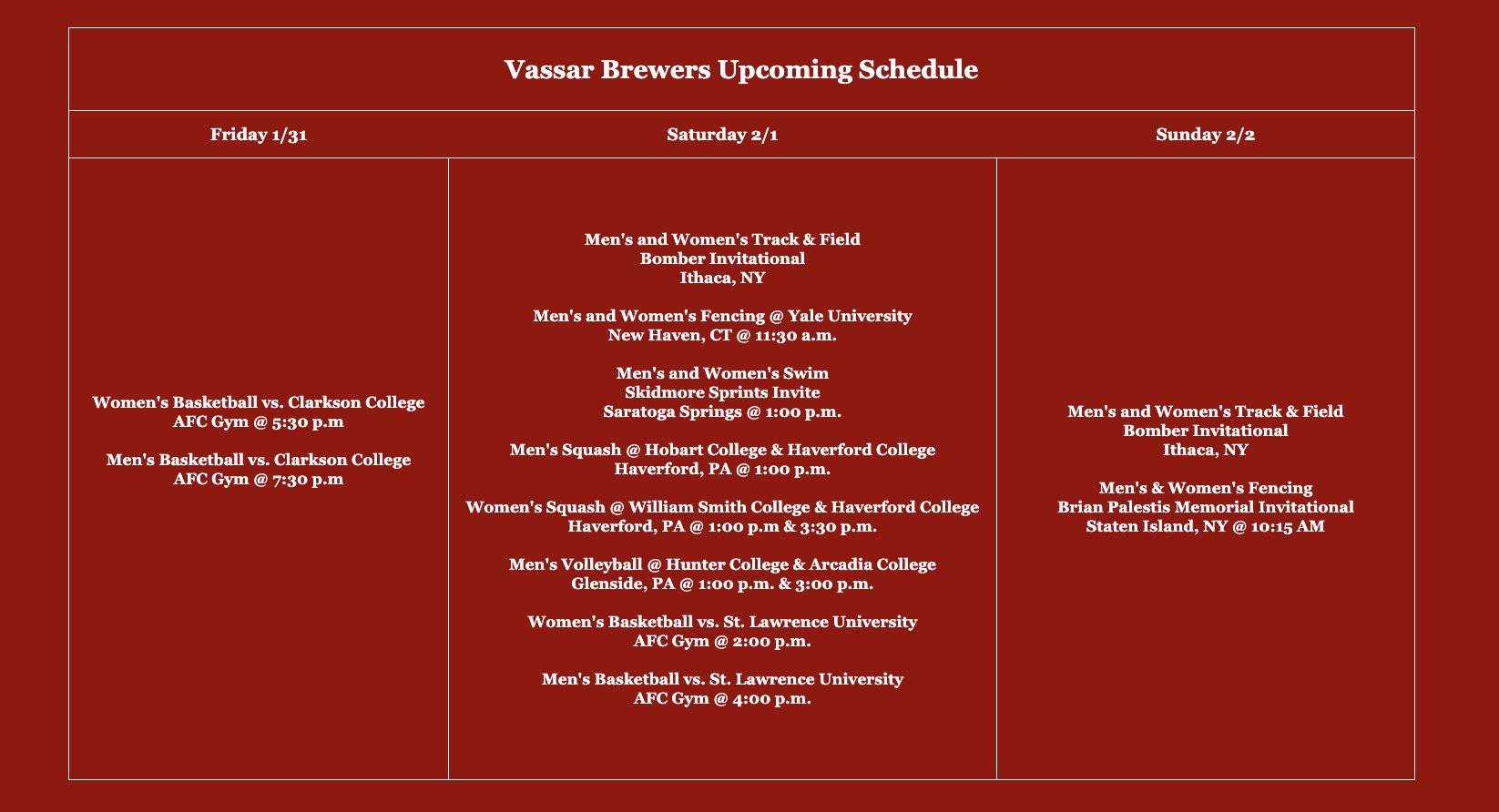
The Miscellany Crossword
Our crosswords are now available to play interactively online! Check out our crosswords tab at miscellanynews.org or find the archive at crossword.miscellanynews.org
“Welcome Back Puzzle”
By Sadie Keesbury
ACROSS
1. Sea in Spanish 4. Sebastian who played the Winter Soldier
8. Drinks, in a pub
10. French airport, or nail polish brand
11. Schnapp or Centineo or Kahan
12. Send to hell 13. Famous fable teller
15. Opposite of yea
16. Begins, as a bag of chips
18. What you
might hear drop if it’s quiet
20. Assignment that might be submitted as a PDF or Word document
23. What you might want to do before you submit 20A
25. Virus that causes vomiting, for short
26. Nevada city that borders California
27. Dry, as climate 28. What to keep a bird in
29. Type of shirt for summer
DOWN
1. A _____ plan, a canal, Panama 2. Plant that produces soothing gel
3. Logic
4. Dirt with grass that might come in a roll
5. Take from one place to the next 6. _____ mater (school of graduation)
7. Initials of the Big Apple 9. Place to buy things
14. Something to put in your step
17. Grandma, to some
18. A type of oxycodone, casually
19. When you have one, a lightbulb might appear above your head
21. Spookiest Great Lake?
22. Was atop, as on a horse
24. Foot finger

Category Match
By Sadie Keesbury
In the word bank below, there are 16 words that belong to four categories. Each word belongs to only one category. You don’t know which words belong together, nor do you know what the categories are! Try to find similarities between them, and place them into four categories below. Answers (which words belong together, as well as the categories they belong to) will be revealed in next week’s issue. Have fun!
Example category: 1: Toyota Car Models COROLLA PRIUS TACOMA HIGHLANDER
WORD BANK CHESS LID ONE WAY STOP

